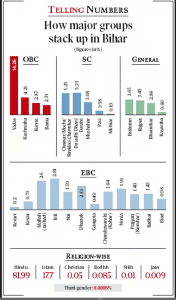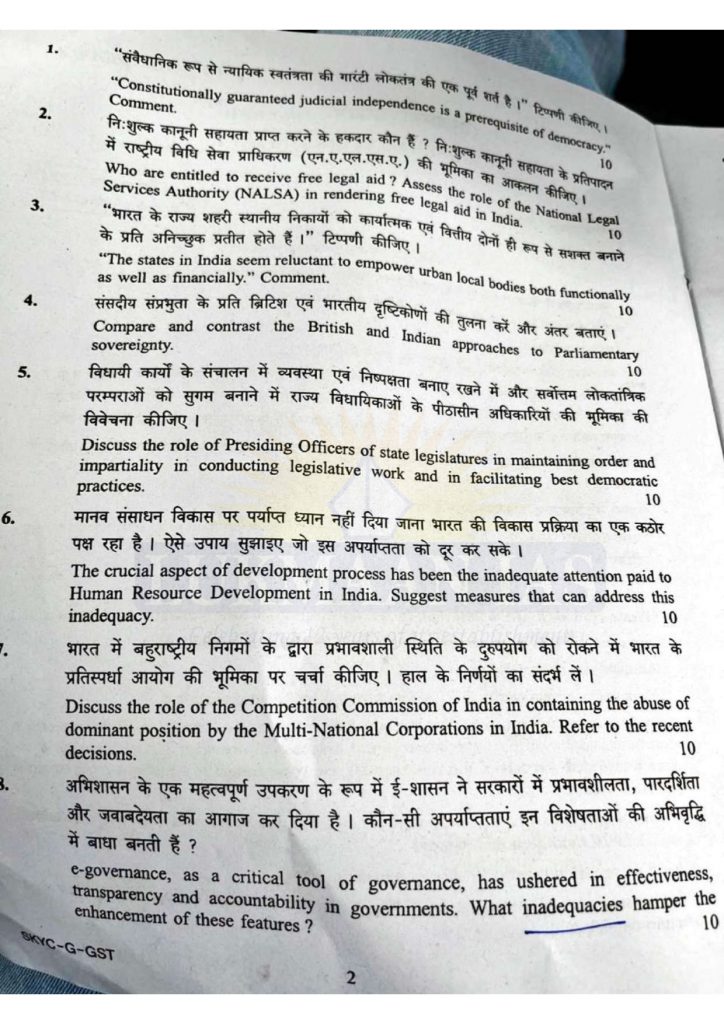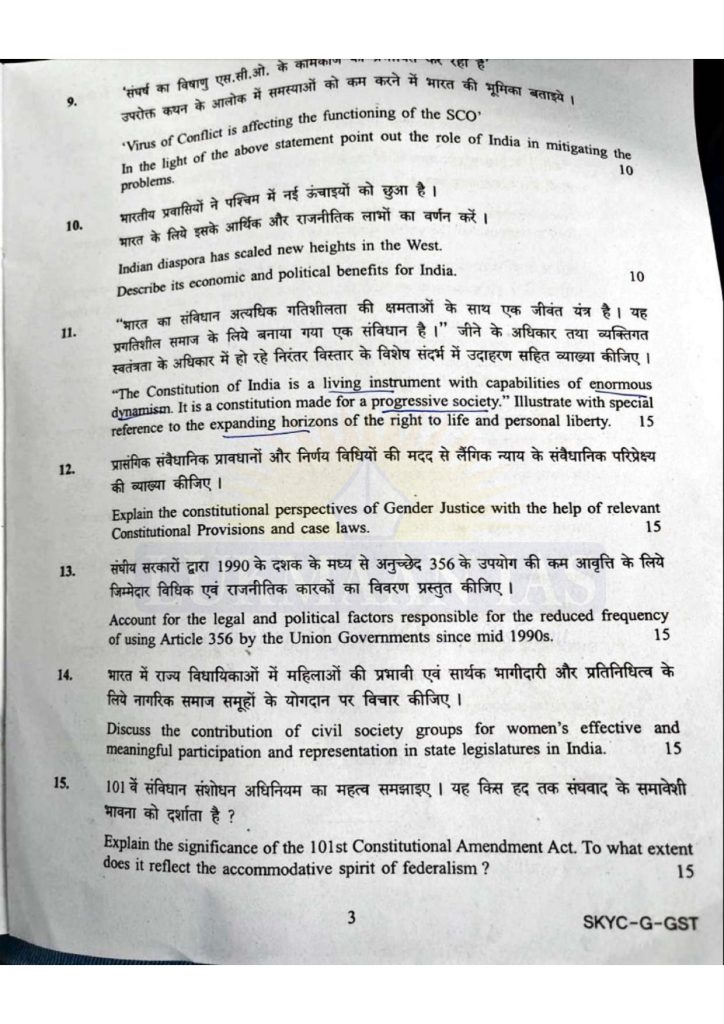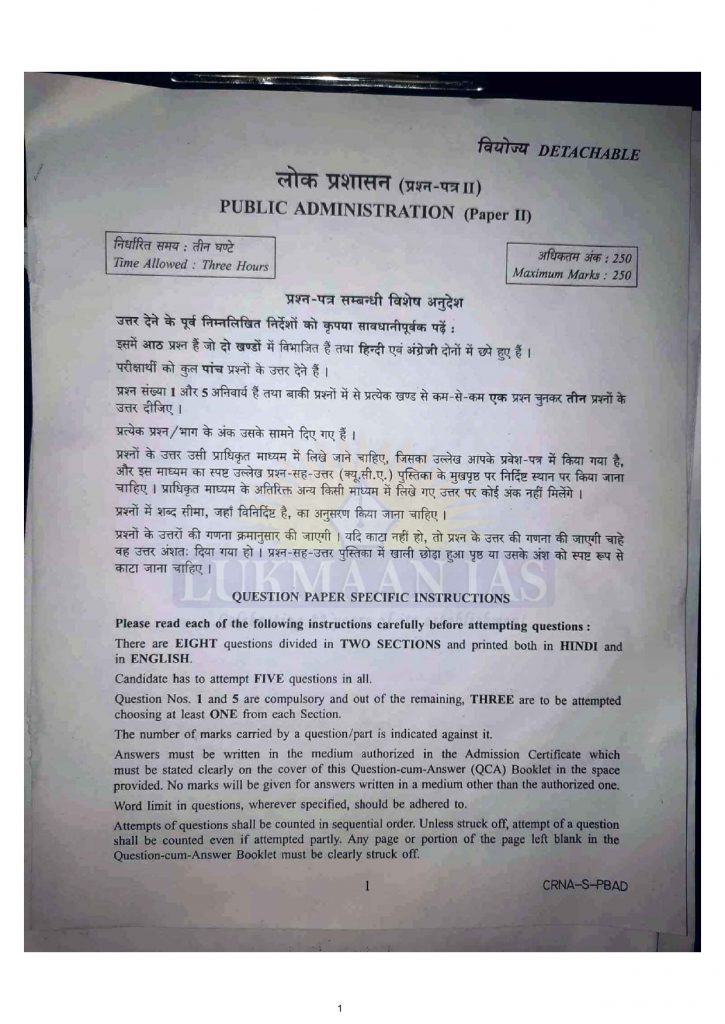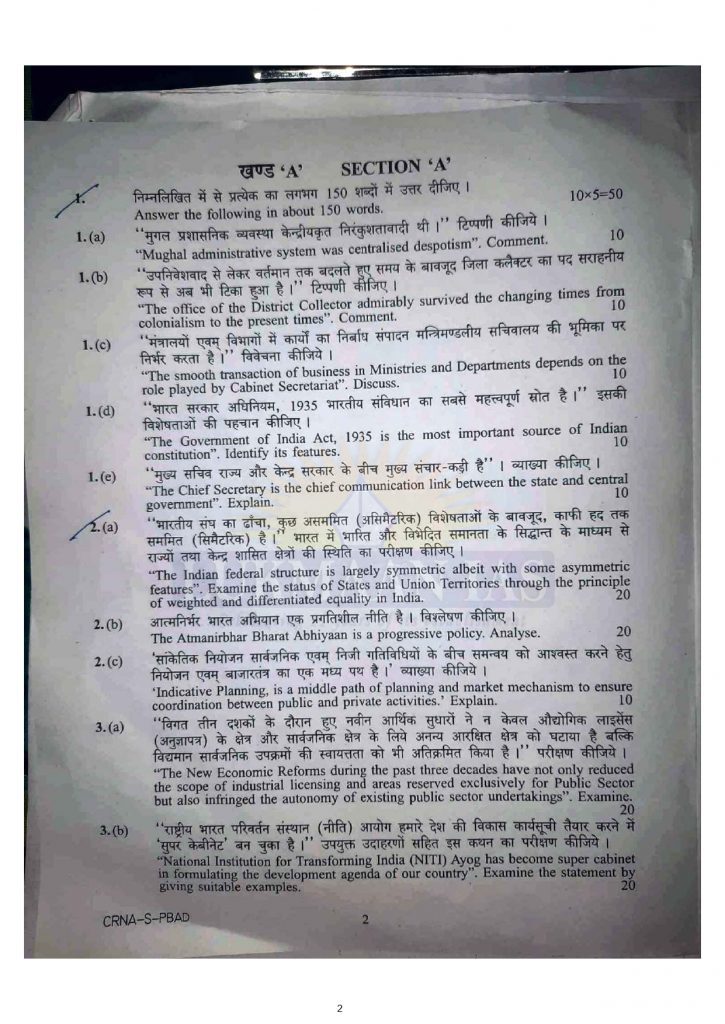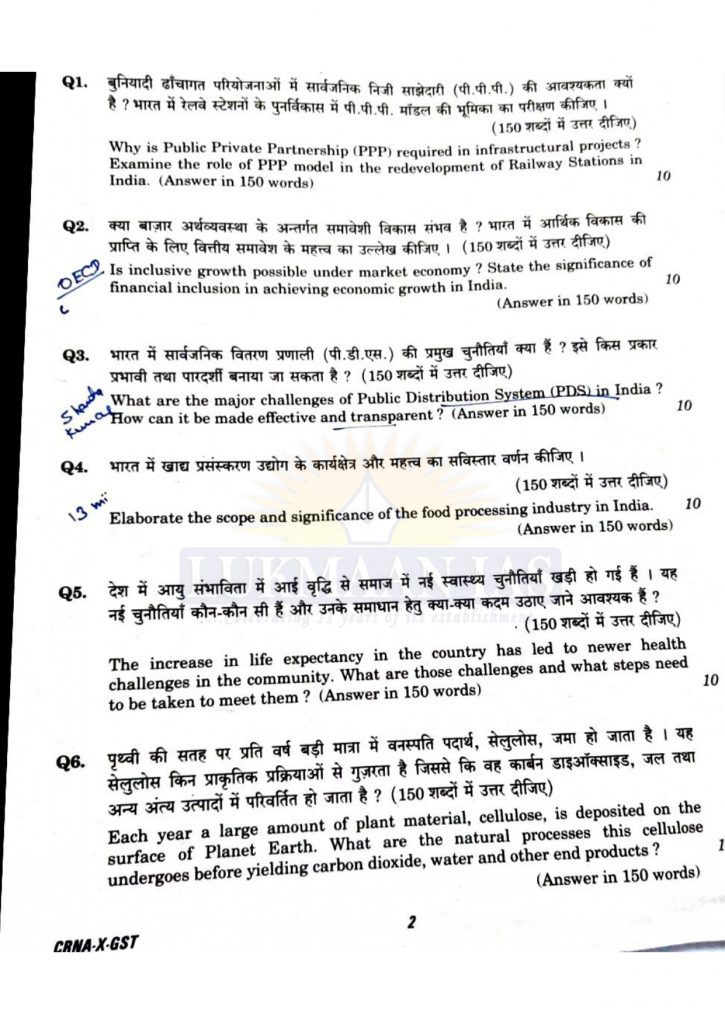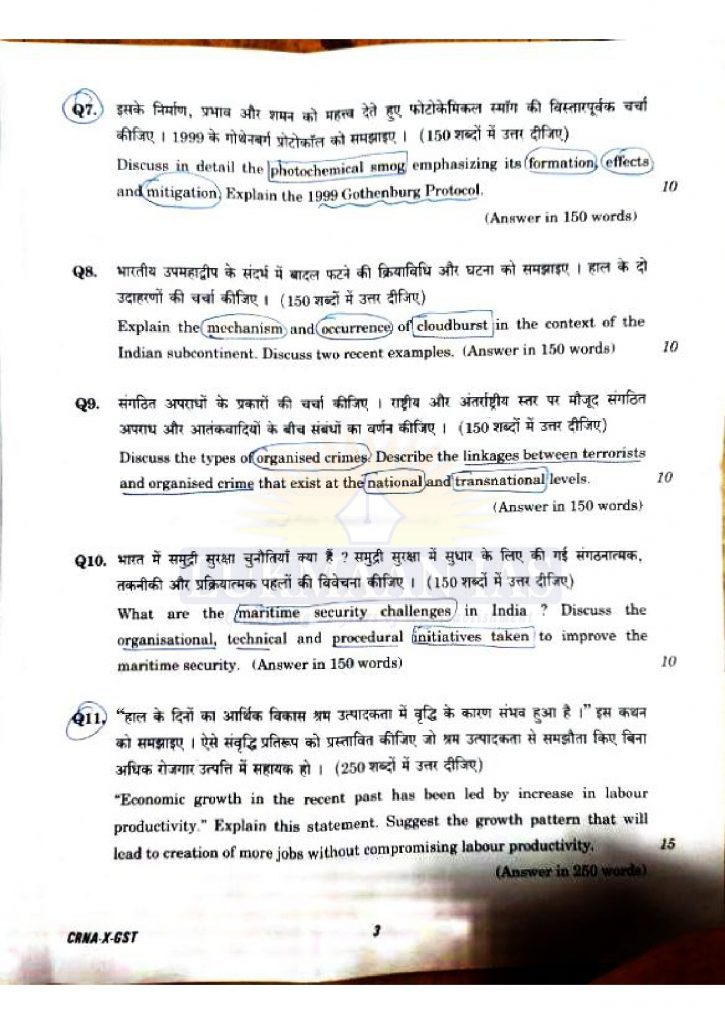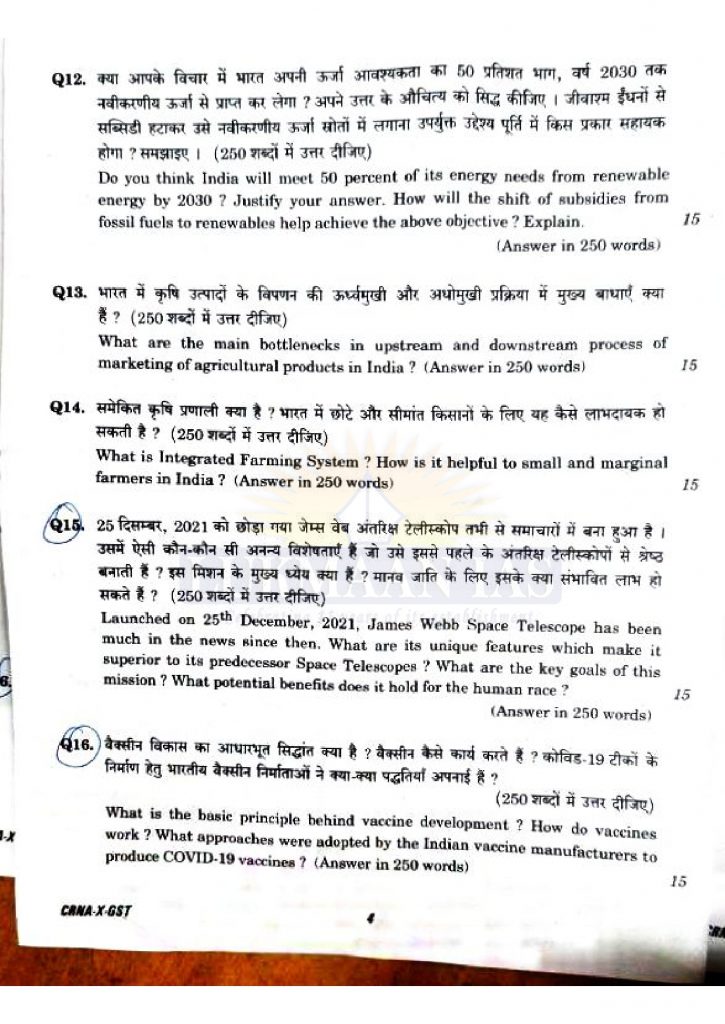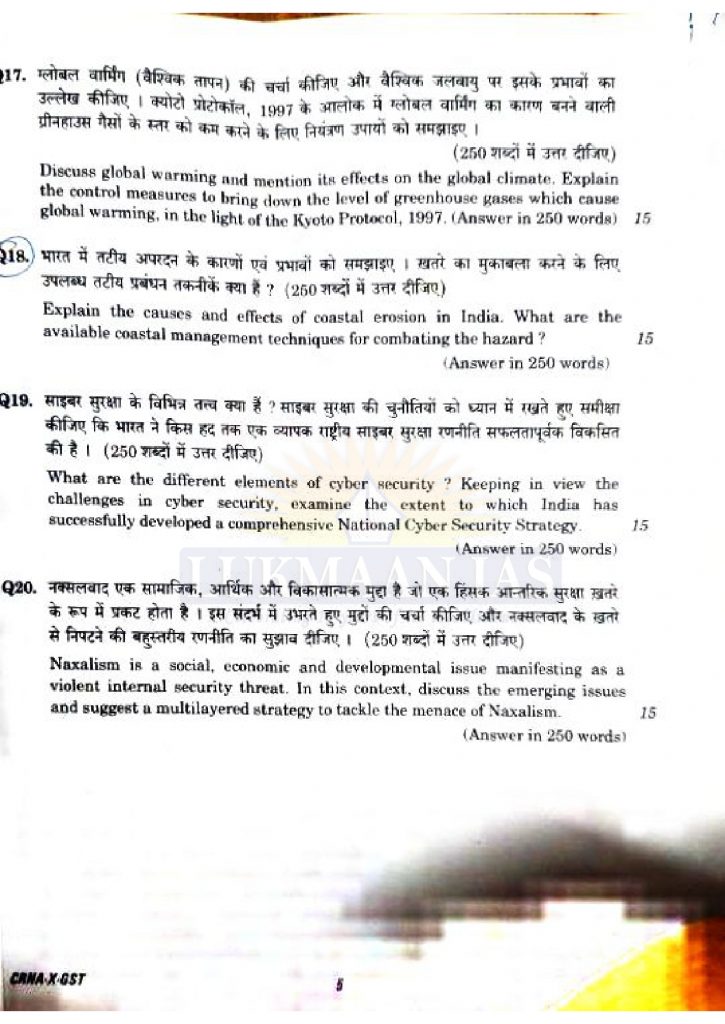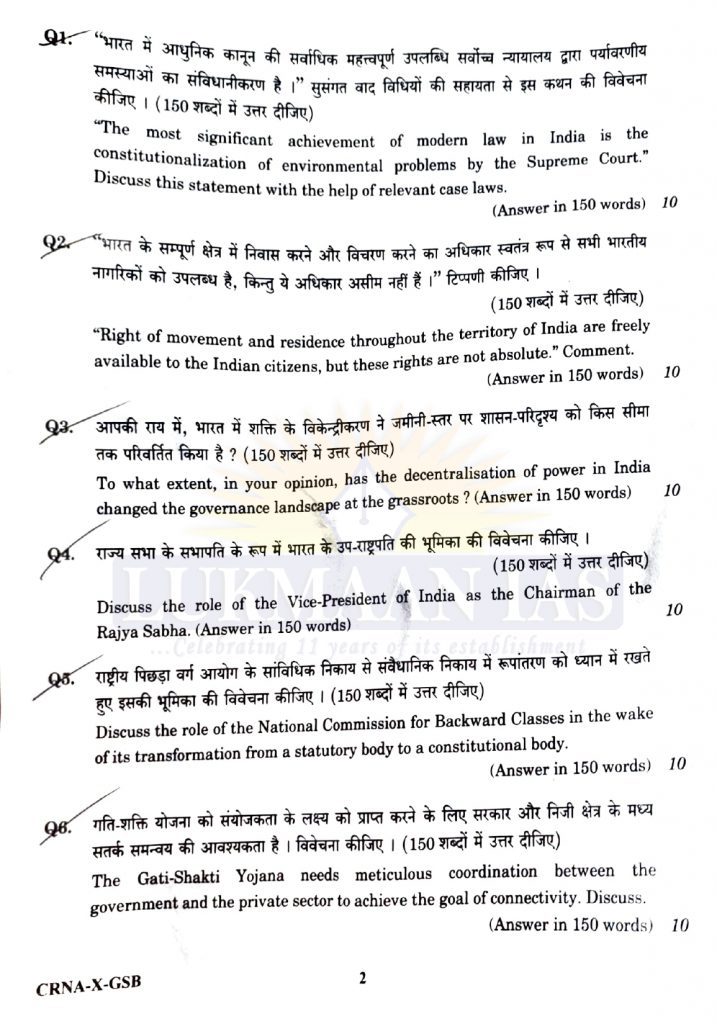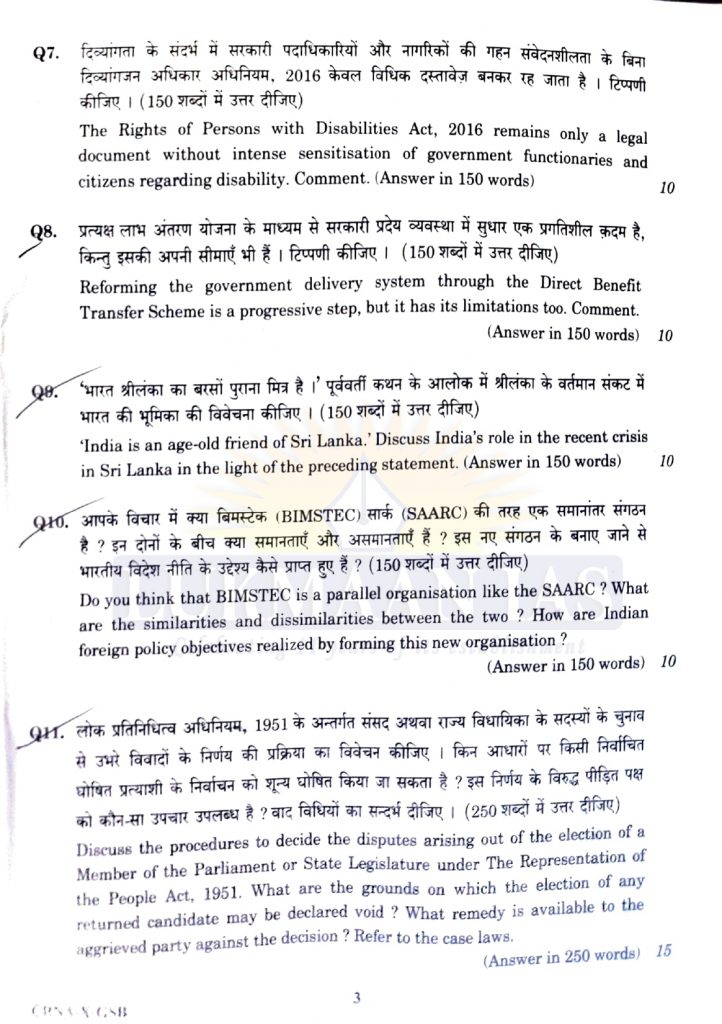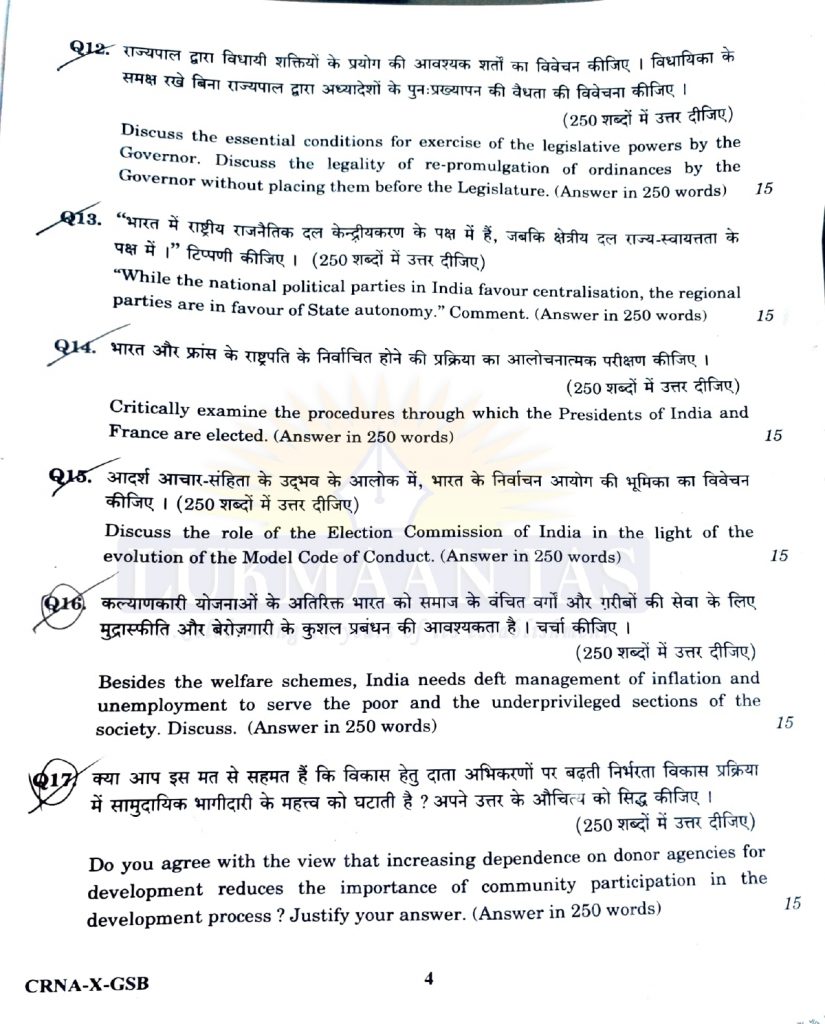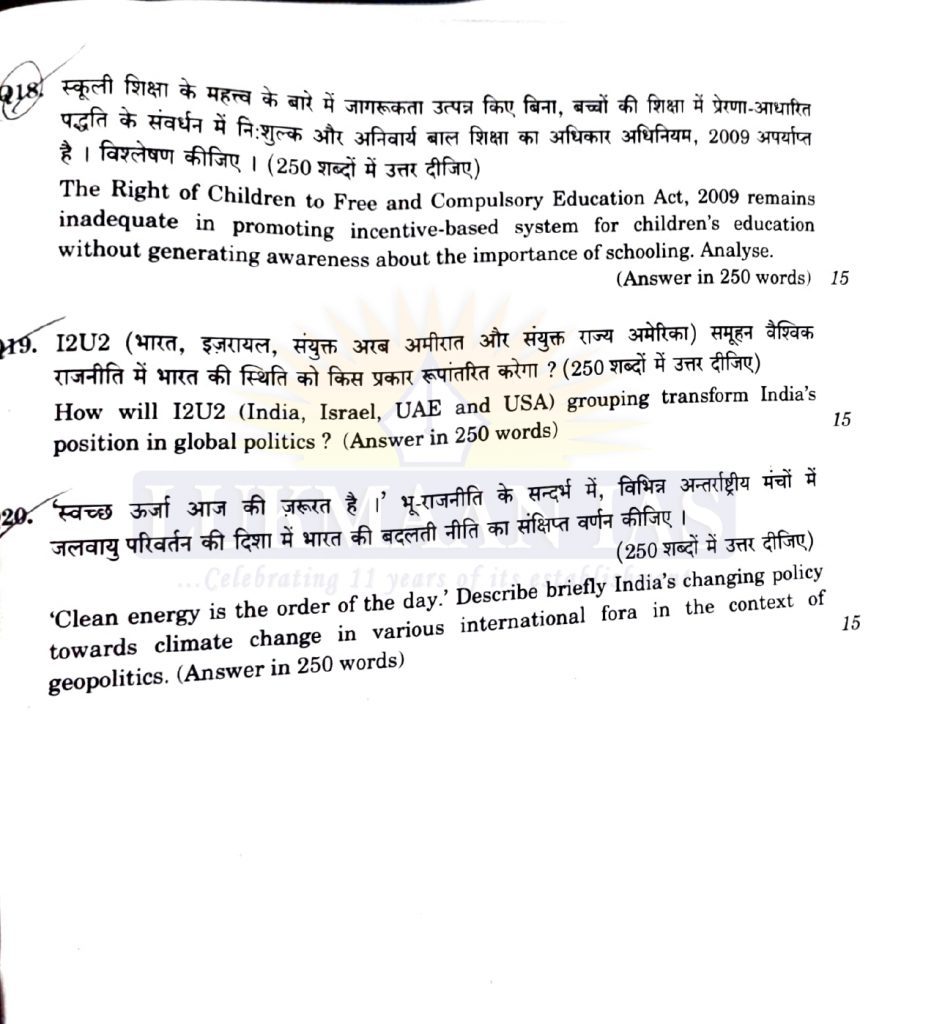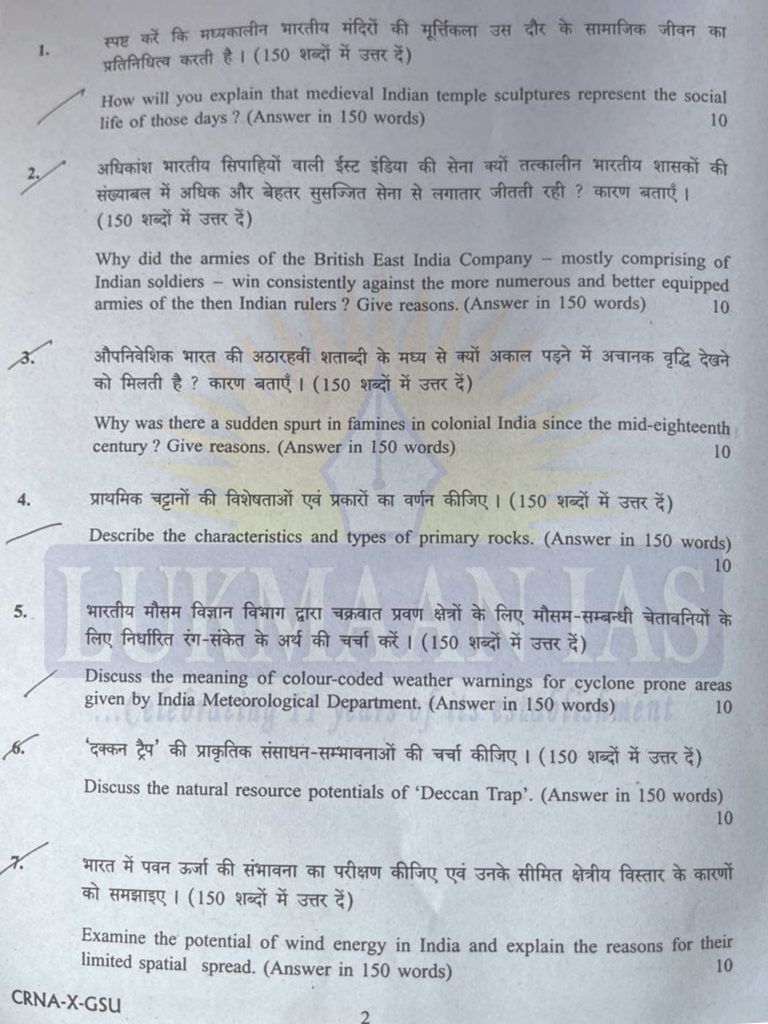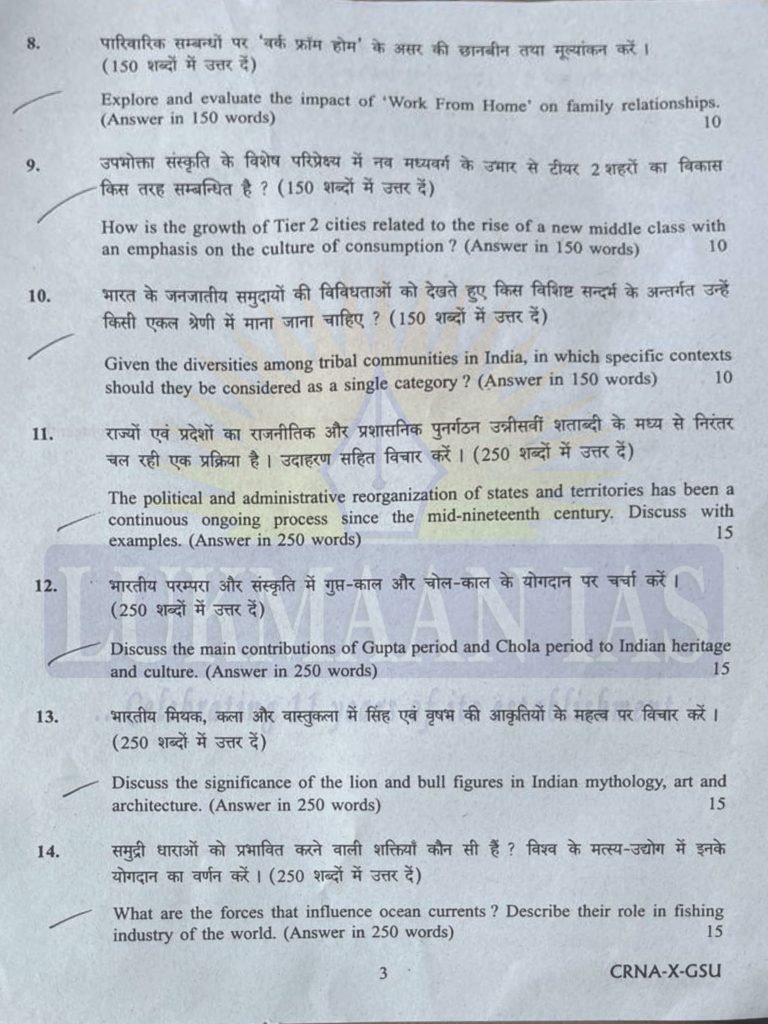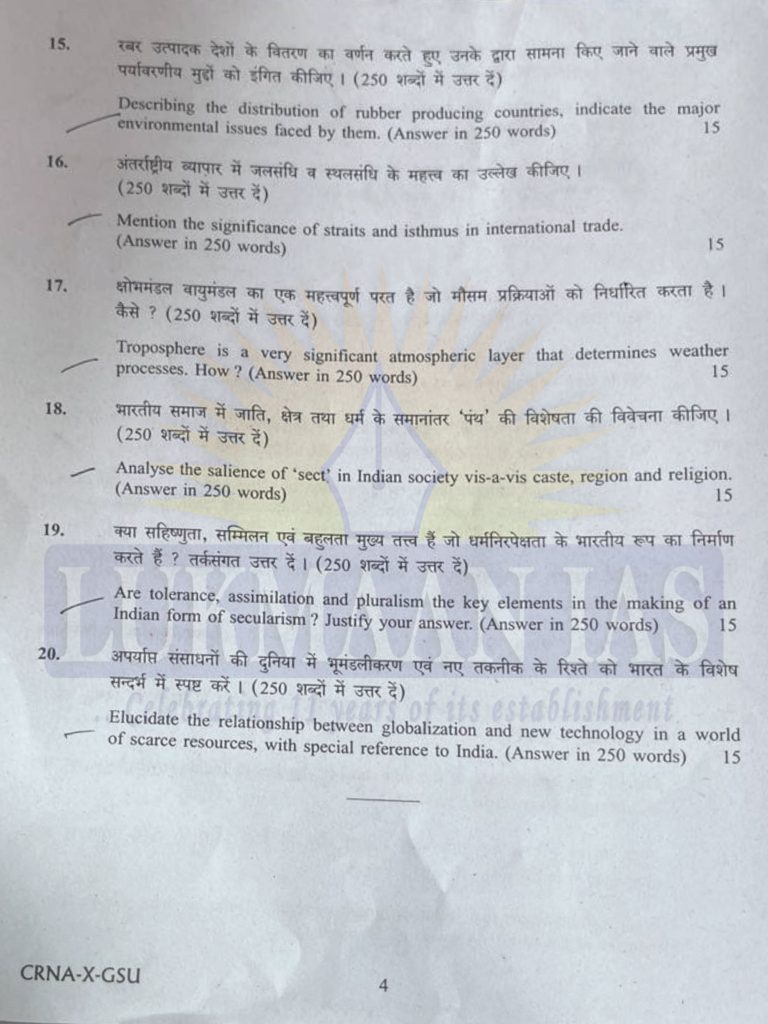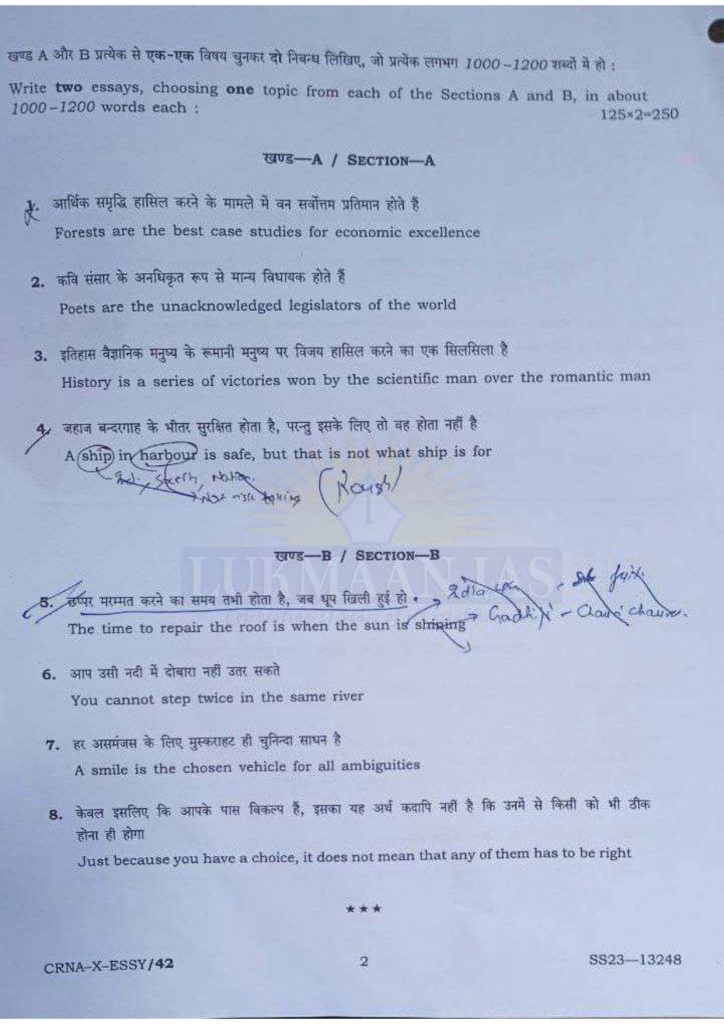UPSC Civil Services Final Result 2023
UPSC Mains Result 2023
UPSC Mains Result-2023
CRIMINAL LAW BILLS AND A HOLLOW DECOLONISATION
CONTEXT: Recently, three Bills, Bharatiya Nyaya Sanhita, 2023 (‘New Penal Bill’), Bharatiya Nagarik Suraksha Sanhita, 2023 (‘New Procedure Bill’) and Bharatiya Sakshya Bill, 2023 (‘New Evidence Bill’), were introduced in the Parliament to replace colonial era legislation for quicker justice and a bid to escape colonial legacy.
MORE ON THE NEWS:
- These three new criminal law Bills have generated concerns, questions and commentary on the changes that have been made. There are also questions about how different the Bills are compared to existing codes and laws.
- While introducing the three criminal law Bills and earlier while setting up the Committee for Reforms in Criminal Law in 2020, a lot was said about the decolonisation that these Bills will bring about.
- However, there are concerns that these Bills do very little to decolonise Indian criminal law and indicate the continuation and intensification of colonial-style powers.
KEY FEATURES OF THE BILLS
BHARATIYA NYAYA SANHITA, 2023
- It replaces the Indian Penal Code, 1860 and , will have 356 sections instead of the earlier 511 sections, 175 sections have been changed, 8 new sections have been added and 22 sections have been repealed.
- Sedition: The Bill removes this offence. It instead penalises the following:
(i) exciting or attempting to excite secession, armed rebellion, or subversive activities,
(ii) encouraging feelings of separatist activities, or
(iii) endangering sovereignty or unity and integrity of India
- Defines Terrorism and Organised Crime: The Bill defines terrorism as an act that intends to threaten the unity, integrity, and security of the country, to intimidate the general public or disturb public order. It also defines organized crime and imposes penalty.
- Protection to Women: The Bill allows death penalty for gang rape of women below 18 years of age. The Bill penalises the act of sexual intercourse with a woman through deceitful means with a simple or rigorous imprisonment up to 10 years, and a fine.
BHARATIYA SAKSHYA BILL, 2023
- It repeals the Indian Evidence Act, 1872, will now have 170 sections instead of the earlier 167, 23 sections have been changed, 1 new section has been added and 5 have been repealed.
- The Act provides rules for the admissibility of evidence in legal proceedings. The Bill retains several parts of the Act. It removes certain colonial references from the Act, widens the ambit of electronic records admissible as evidence, and removes provisions related to telegraphic messages.
- Admissibility of electronic or digital records as evidence: The Act provides for two kinds of evidence – documentary and oral evidence. The Bill provides that electronic or digital records will have the same legal effect as paper records.
- Expand the definition of document: The law expands the definition of documents to include electronic or digital records, e-mails, server logs, computers, smart phones, laptops, SMS, websites, locational evidence, mails, messages on devices.
BHARTIYA NAGARIK SURAKSHA SANHITA BILL, 2023
- It will replace Criminal Procedure Code, 1898, now has 533 sections, 160 sections of old law have been changed, 9 new sections have been added and 9 sections have been repealed.
- Trials in electronic mode: The Bill provides that all trials, inquires, and proceedings may be held in electronic mode.
- Forensic investigation: The Bill mandates forensic investigation for offences punishable with at least seven years of imprisonment.
- Timelines for procedures: The Bill prescribes timelines for various procedures. For instance, it requires medical practitioners who examine rape victims to submit their reports to the investigating officer within seven days. Other specified timelines include:
- Giving judgement within 30 days of completion of arguments (extendable up to 60 days)
- Informing the victim of progress of investigation within 90 days
- Framing of charges by a sessions court within 60 days from the first hearing on such charges.
SIGNIFICANCE OF THE BILLS
- Decolonisation of laws: These three outgoing laws were made to strengthen the British rule and their purpose was to punish not to give justice and had signs of slavery. These news laws have been passed for decolonization of laws and to remove these signs of slavery.
- Protect rights of citizens: The soul of the three new laws is to protect all the rights given to Indian citizens by the constitution, and, their purpose is to give justice.
- Transparency and Efficiency: The new provision has been made through these laws to enhance transparency and efficiency of the system. It is done by digitization of entire process of criminal justice system from FIR to case diary, case diary to charge sheet and charge sheet to judgement.
- Quicker justice: Provision has been made in India’s criminal justice system for quicker justice that now anyone will be able to get justice within a maximum of 3 years. It will be compulsory for the Police to give the status of the complaint in 90 days and thereafter every 15 days, to the complainant.
ISSUES IN THE BILLS
- Opacity in the crafting of the Bills: There is issue raised of opacity in crafting of the Bills as the inputs of the stakeholders and the final report of the MHA’s Committee For Reforms In Criminal Laws (CRCL) has not been put in the public domain.
- Issue of increased suspicion: The framework produced by the Bills views citizens with such increased suspicion and mistrust that the state appears to almost be in opposition to the citizen.
- Continuation of colonial power: A notable feature of colonisation is suppression in the pretext of security by giving the executive unchecked police powers. The Bharatiya Nagarik Suraksha Sanhita (BNSS) Bill expands the police power as it allows police custody for periods longer than is allowed under the current Criminal Procedure Code. This legislative increase in the use of police or police adjacent powers, is a continuation of colonial powers and not a route for undoing them.
- Inadequate police and prison reforms: Police and Prison has been seen as relics of colonization. Yet, the decolonisation that the Bills seek to achieve provides no scope for their reform.
WAY FORWARD
- Development with Decolonisation: The narrative of decolonisation surrounding the Bills must not be seen in isolation from developments. The areas of criminal lawmaking should work for both development and decolonization.
- Need to reflect changed relationship between state and citizen: A ‘decolonised’ or a post-colonial law, would necessarily need to reflect the changed relationship between the citizen and the state. This fundamental shift changes the process of law-making, and the priorities and purpose of the law.
- Reforms in institutions: There is need to take stringent action for reforms in institutions of police and prison by increasing Without reorienting the foundational perspective of these institutions calls for decolonisation will remain impassive.
CONCLUSION
Though the newly introduced legislation is a significant step forward in reforming criminal justice system in India. But the issue of decolonization of the laws still persists. There is need to give effect to reordered relationships between the state and citizen through these laws to ensure effective justice delivery.
PREVIOUS YEAR QUESTION
Q.1 We are witnessing increasing instances of sexual violence against women in the country. Despite existing legal provisions against it, the number of such incidences is on the rise. Suggest some innovative measures to tackle this menace. (2014)
Q.2 Mob violence is emerging as a serious law and order problem in India. By giving suitable examples, analyze the causes and consequences of such violence. (2015)
MAINS PRACTICE QUESTIONS
Q.1 Recently, three Bills have been introduced in the Parliament to reform the criminal justice system in India. Analyze the potential benefits and concerns associated with these proposed changes.
Q.2 Criminal Justice Reforms for decolonization require not only legislative changes but also institutional and social changes. Comment.
BIHAR CASTE SURVEY: A WELCOME STEP
CONTEXT: The Bihar government has recently released the results of its recently concluded survey of castes in the state.
KEY FINDINGS OF THE SURVEY
• The survey puts the share of Extremely Backward Classes (EBCs) and Other Backward Classes (OBCs) cumulatively at more than 63% (EBC :36.01% and OBC: 27.12%). The “unreserved” category of so-called “forward” castes is about 15.52% and scheduled castes 19.65% and Scheduled Tribes (STs) are (1.68%).
• Bihar’s population, according to the survey, is 13.07 crore compared to the 10.41 crore recorded in the 2011 census. Hindus comprise 81.99% of the population, and Muslims 17.72%. The populations of Buddhists, Christians, Sikhs, Jains, and other religious denominations are minuscule.
WHAT IS A CASTE CENSUS?
• Caste census means inclusion of caste-wise tabulation of India’s population in the Census exercise.
• India has counted and published caste data from 1951 to 2011of the Scheduled Castes and Scheduled Tribes only. It also publishes data related to religions, languages and socio economic status.
• The Ministry of Rural Development Government of India, commenced the Socio Economic and Caste Census (SECC) 2011, in June 2011 through a comprehensive door to door enumeration across the country.
• However, SECC 2011 did not publish the caste data. The SECC data excluding caste data was finalized and published in 2016.
SIGNIFICANCE OF THE CASTE SURVEY:
• Identity Politics: Caste survey can enforce Identity politics as it will become easier to resonate with vote bank politics. Party campaign tends to play upon fixed identities and harnessing the ides of shared ideas and shared concerns. Also, in the case of Bihar unified EBC leadership may receive a new fillip. Similarly, Political coalition will get shaped and reshaped.
• Amplify calls for enumeration outside state:Bihar’s caste survey will also amplify calls for enumeration outside the stateand even on nationwide.This comes amid submission of Justice G Rohini Commission report.
• Inclusive growth: Caste based survey can acts as equalizing forces. With the help of caste numbers an informed public decision making can be done with at the same time giving aspiration and freedom of opportunity to marginalized sections. The survey has not only considered one’s caste but also one’s economic status, which would help us devise further policies and plans for the development of all classes.”
• Renewed demand for reservation: It may create opportunity for renewed backward class mobilization and can amplify demand for OBC quota beyond 27%. The survey data will also reopen the longstanding debate over the 50% ceiling on reservation imposed by the Supreme Court in its landmark ruling in Indra Sawhney v Union of India (1992).
ISSUES INVOLVED:
• Not holistic image: The survey may not capture the holistic image of the dynamic changes which may lead to inaccurate representations of reality. The dynamic changes may include intra caste variation and associated historical changes that fail to take into account contemporary changes.
• Political Manipulation: Caste-based data can beexploited by politicians for short-term gainsleading to vote bank politics. This can divert attention from genuine policy issues and can led to division in society.
• Stigmatization of marginalized groups: Disclosure of caste identities could lead to individuals being stigmatized or discriminated against based on preconceived notions associated with certain castes.
• Census under the union list:Census is conducted under the provisions of the Census Act, 1948.According to the constitution, Census is aUnion subject under list I, entry 69, schedule 7. Thus, it is held that it empowers only the central government to conduct census. Hence, by conducting the survey the state is violating the constitutional provisions according to critics.
WAY FORWARD:
• Balanced approach: There is a need of balanced approach for conducting a caste-based survey with establishing a clear ethical framework with informed consent that prioritizes privacy and dignity of citizens.
• Awareness campaigns: Public awareness campaigns with regular reviews and capacity-building initiatives can contribute to a long-term vision of conducting census with aim of reducing inequalities and fostering social integration.
• Uphold democratic principles: The census data should not become a weapon for increasing polarization to win elections and there is need to uphold democracy and the enhance the notion of representative democracy.
• Undoing historical injustice: Caste census data can be used as an instrument to address historically embedded backward and inequality and it can provide government opportunity for social justice.
CONCLUSION: There is no doubt that the publication of the Bihar caste survey results is an important moment in national politics. However, data must be handled with care and should not lead to shrinking of the very notion of representation in a large and diverse democracy.
SOURCE: https://indianexpress.com/article/opinion/editorials/bihar-caste-survey-a-welcome-step-8965726/
PREVIOUS YEAR QUESTION
1. How do you explain the statistics that show that the sex ratio in Tribes in India is more favourable to women than the sex ratio among Scheduled Castes? (2015)
2. Though there have been several different estimates of poverty in India, all indicate reduction in poverty levels over time. Do you agree? Critically examine with reference to urban and rural poverty indicators. (2015)
MAINS PRACTICE QUESTIONS
1. How can Caste based Survey help policymakers design and implement more effective policies to reduce socio-economic inequalities? Comment.
2. How Caste based Census can shape the identity politics in the country at regional and national level? Explain.
GS PAPER-IV: UPSC CSE Mains-2023 (Question Paper)
GS PAPER-III: UPSC CSE Mains-2023 (Question Paper)
https://www.youtube.com/watch?v=5ViMq3O5u08https://www.youtube.com/watch?v=p1NeuaL1AFkhttps://youtu.be/XKQNSUHl9dc?list=PL48n6erI_cjAhNan9sfBfU9qGFodeKGDehttps://youtu.be/1wXGRfYmn3khttps://youtu.be/OT5ufxvH2Uw?list=PL48n6erI_cjAhNan9sfBfU9qGFodeKGDehttps://youtu.be/NBDvTk7G_Vw
DOWNLOAD MODEL ANSWER
DOWNLOAD TOPICWISE ANALYSIS
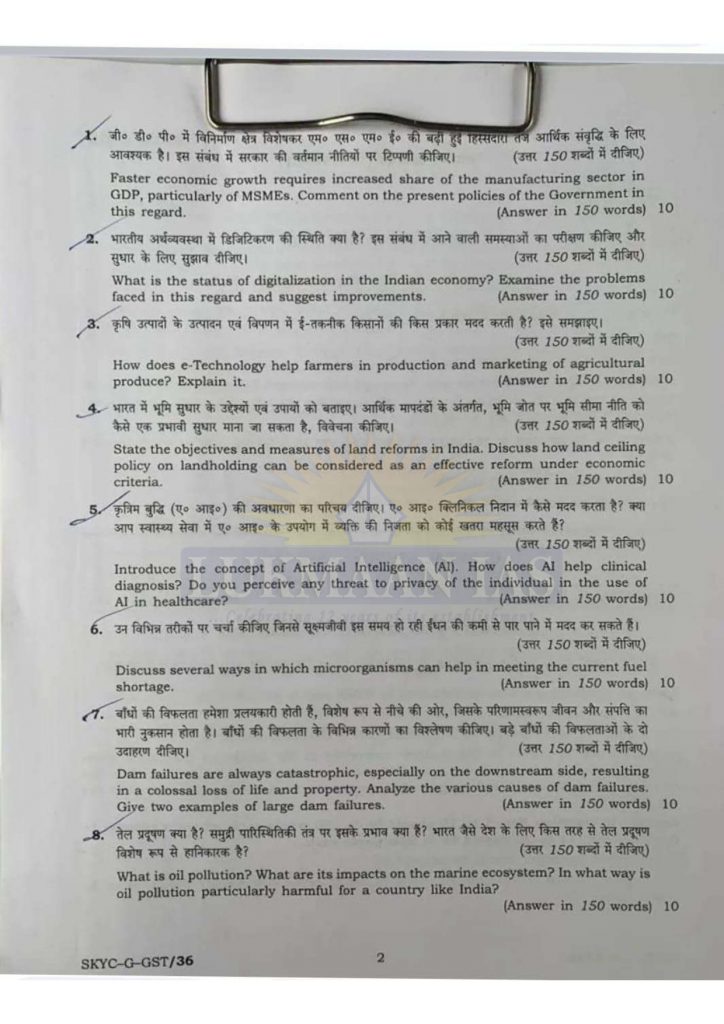
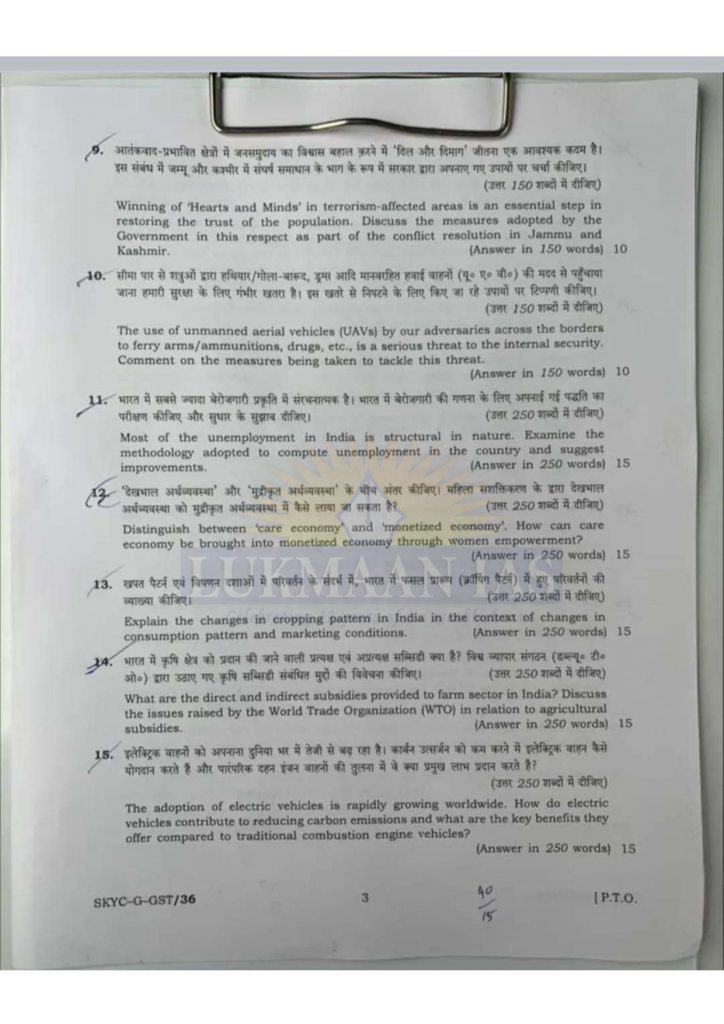
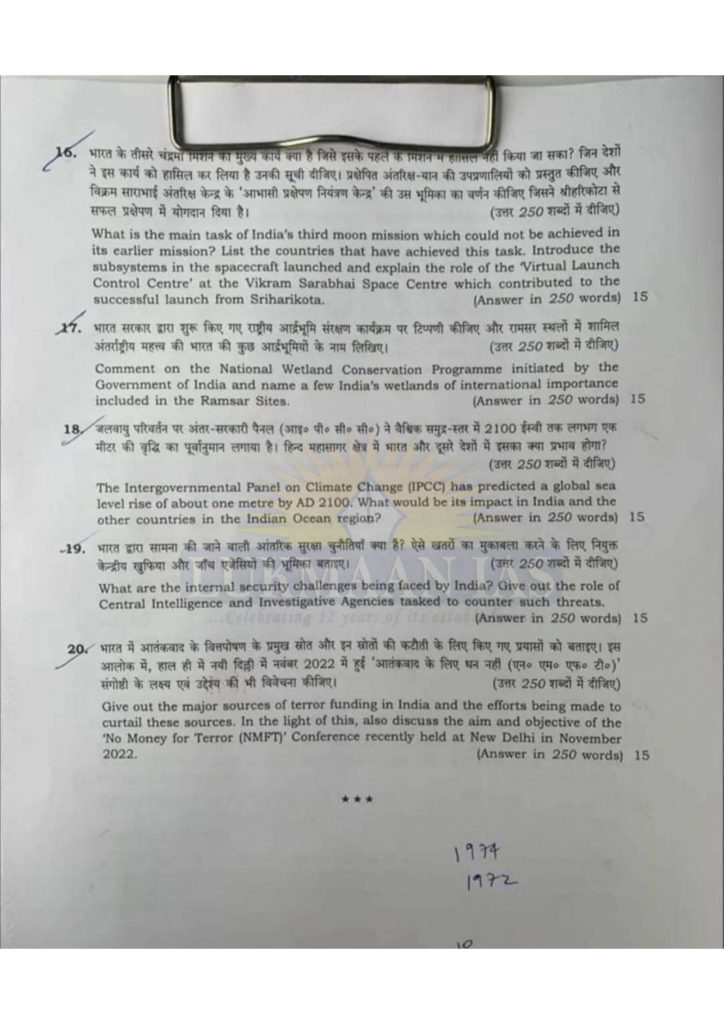
GS PAPER-II: UPSC CSE Mains-2023 (Question Paper)
GS PAPER-1: UPSC CSE Mains-2023 (Question Paper)
https://www.youtube.com/watch?v=7WgZ5WDDIBMhttps://www.youtube.com/watch?v=p1NeuaL1AFkhttps://www.youtube.com/watch?v=HON50lfVuDMhttps://www.youtube.com/watch?v=JMrslk_DAUw
DOWNLOAD MODEL ANSWER
DOWNLOAD TOPICWISE ANALYSIS
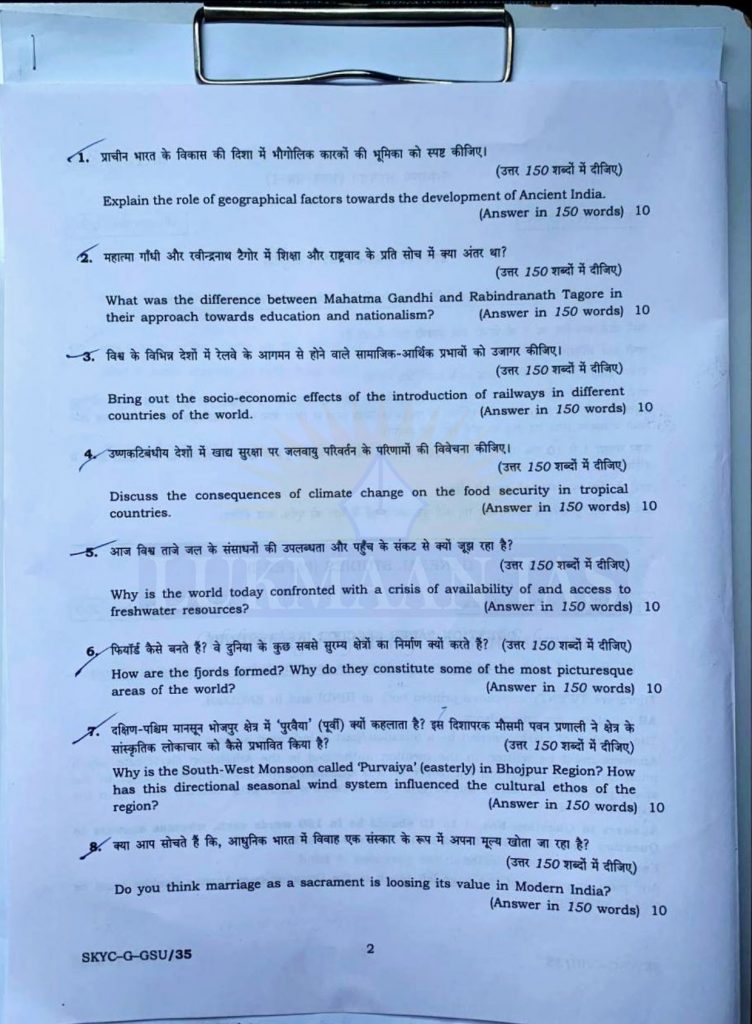
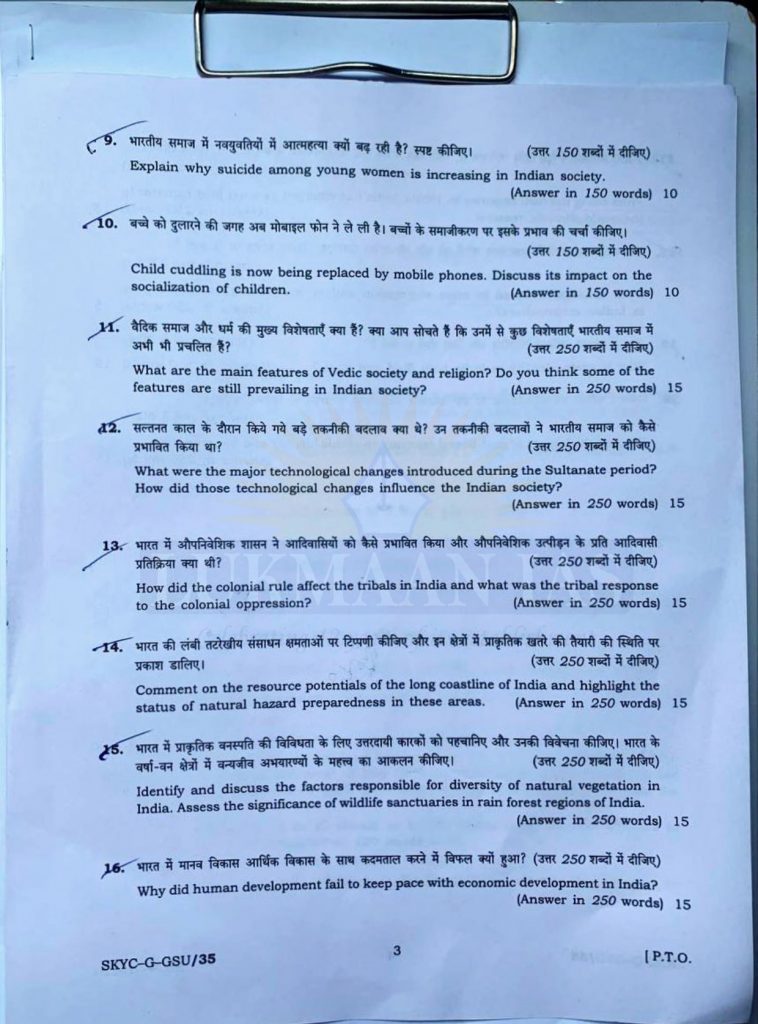
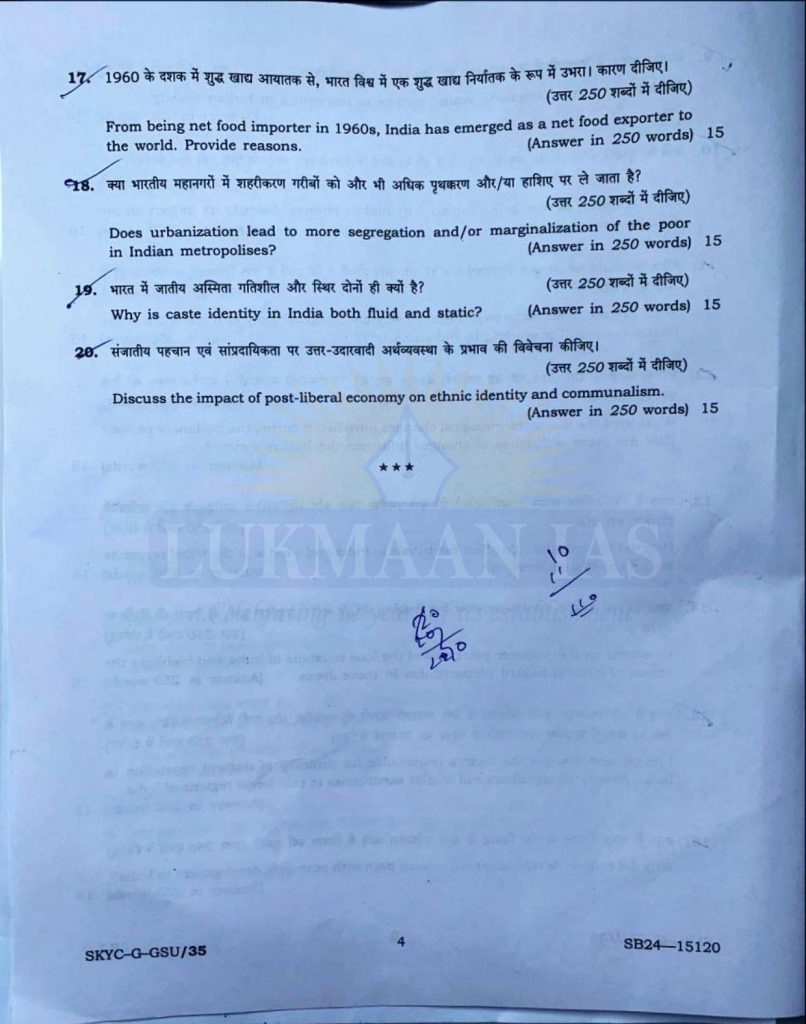
Q1. Explain the role of geographical factors towards the development of Ancient India.
Q2. What was the difference between Mahatma Gandhi and Rabindranath Tagore in their approach towards education and nationalism?
Q3. Bring out the socio-economic effects of the introduction of railways in different countries of the world.
Q4. Discuss the consequences of climate change on the food security in tropical countries.
Q5. Why is the world today confronted with a crisis of availability of and access to freshwater resources?
Q6. How are the fjords fromed? Why do they constitute some of the most picturesque areas of the world?
Q7. Why is the South-West Monsoon called ‘Purvaiya’ (easterly) in Bhojpur Region? How has this directional seasonal wind system influenced the cultural ethos of the region?
Q8. Do you think marriage as a sacrament is loosing its value in Modern India?
Q9. Explain why suicide among young women is increasing in Indian society.
Q10. Child cuddling is now being replaced by mobile phones. Discuss its i8mpact on the socialization of children.
Q11. What are the main features of Vedic society and religion? Do you think some of the features are still prevailing in Indian society?
Q12. What were the major technological changes introduced during the Sultanate period? How did those technological changes influence the Indian society?
Q13. How did the colonial rule affect the tribals in India and what was the tribal response to the colonial oppression?
Q14. Comment on the resource potentials of the long coastline of India and highlight the status of natural hazard preparedness in these areas.
Q15. Identify and discuss the factors responsible for diversity of natural vegetation in India. Assess the significance of wildlife sanctuaries in rain forest regions of India.
Q16. Why did human development fail to keep pace with economic development in India?
Q17. From being net food importer in 1960s, India has emerged as a net food exporter to the world. Provide reasons.
Q18. Does urbanization lead to more segregation and/or marginalization of the poor in Indian metropolises?
Q19. Why is caste identity in India both fluid and static?
Q20. Discuss the impact of post-liberal economy on ethnic identity and communalism.
Essay Question Paper: UPSC CSE Mains 2023
ESSAY QUESTION PAPER – UPSC Civil Services (Mains – 2023)
DOWNLOAD QUESTION PAPER
DOWNLOAD MODEL ANSWER
MATCHED QUESTIONS
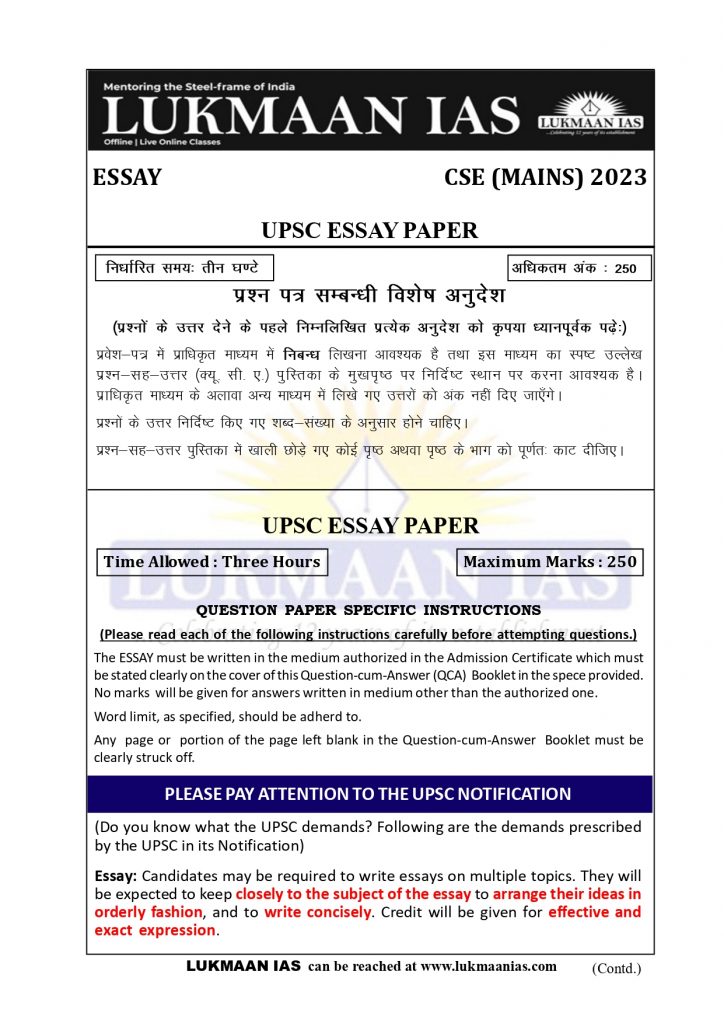
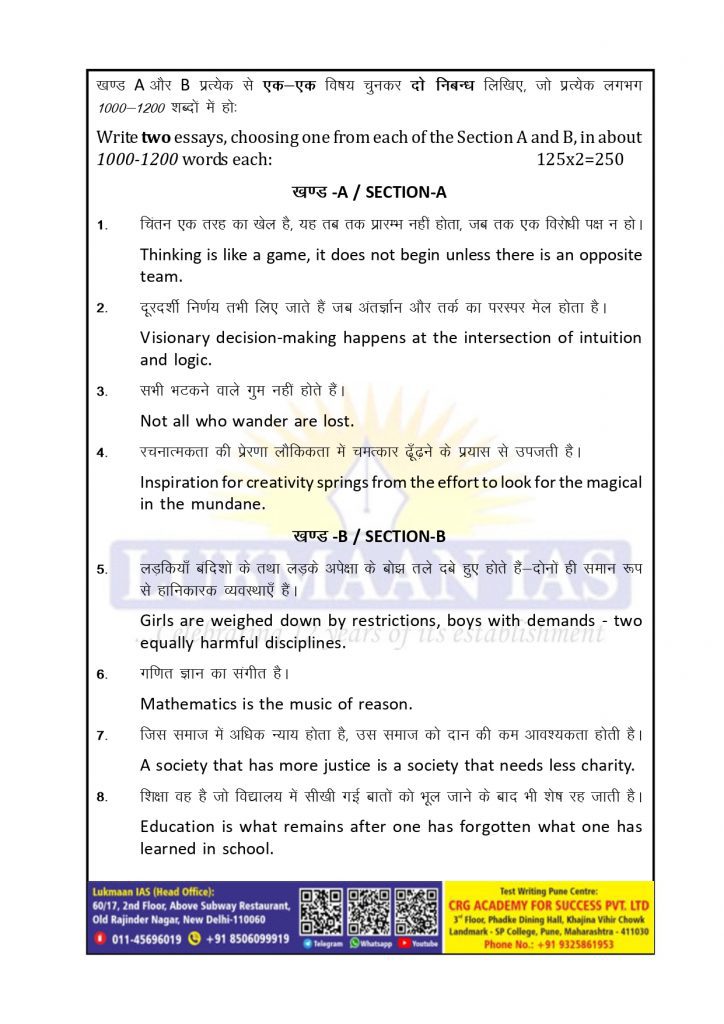
SECTION-A
- 1. Thinking is like a game, it does not begin unless there is an opposite team.
- 2. Visionary decision-making happens at the intersection of intuition and logic.
- 3. Not all who wander are lost.
- 4.Inspiration for creativity springs from the effort to look for the magical in the mundane.
SECTION-B
- 5. Girls are weighed down by restrictions, boys with demands – two equally harmful disciplines.
- 6. Mathematics is the music of reason.
- 7. A society that has more justice is a society that needs less charity.
- 8. Education is what remains after one has forgotten what one has learned in school.
UPSC Prelims Question Paper 2023
UPSC Prelims Result 2023
UPSC Prelims Question Paper 2023
UPSC Prelims Answer Key & Explanation 2023
@media( min-width: 1px ) and ( max-width:767px ) { #premium-img-gallery-31f6f00 .premium-gallery-caption { display: none; } }UPSC Civil Services Final Result 2022
UPSC Civil Services Final Result 2022
UPSC Civil Services Mains Result 2022
UPSC Civil Services Mains Result 2022
SOCIOLOGY OPTIONAL QUESTION PAPER : UPSC CSE Mains-2022
PUBLIC ADMIN. (PAPER-II) QUESTION PAPER : UPSC CSE Mains-2022
PUBLIC ADMIN. (PAPER-I) QUESTION PAPER : UPSC CSE Mains-2022
https://youtu.be/W1gk2EKXC7ghttps://youtu.be/zOO2zZWAIoohttps://youtu.be/oAbUcdcNQcI
DOWNLOAD PDF
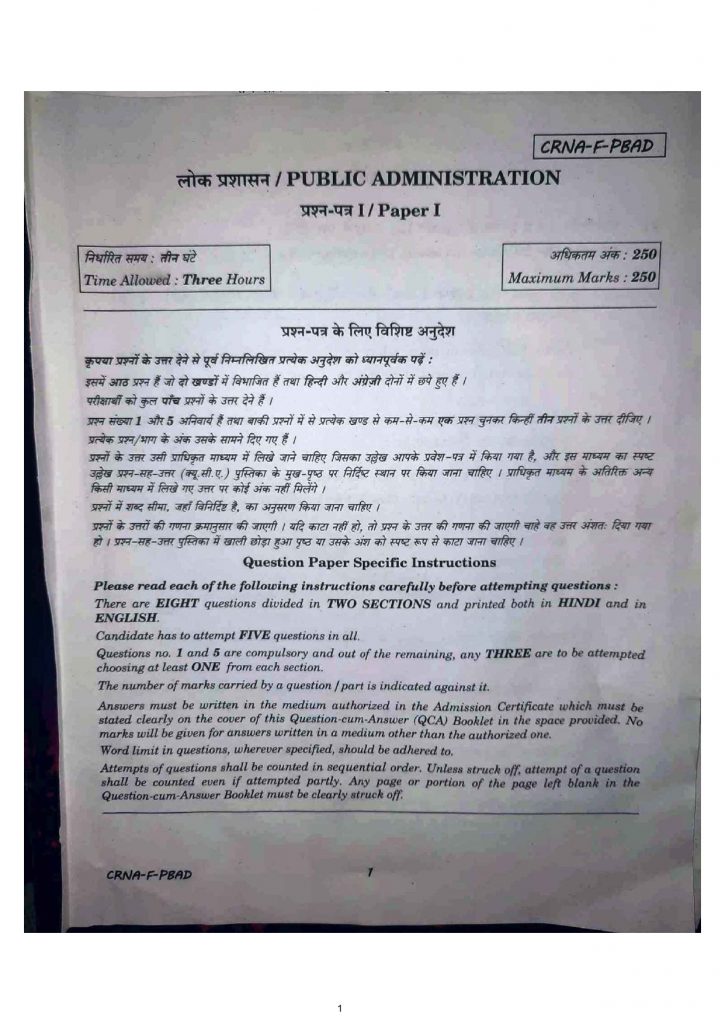
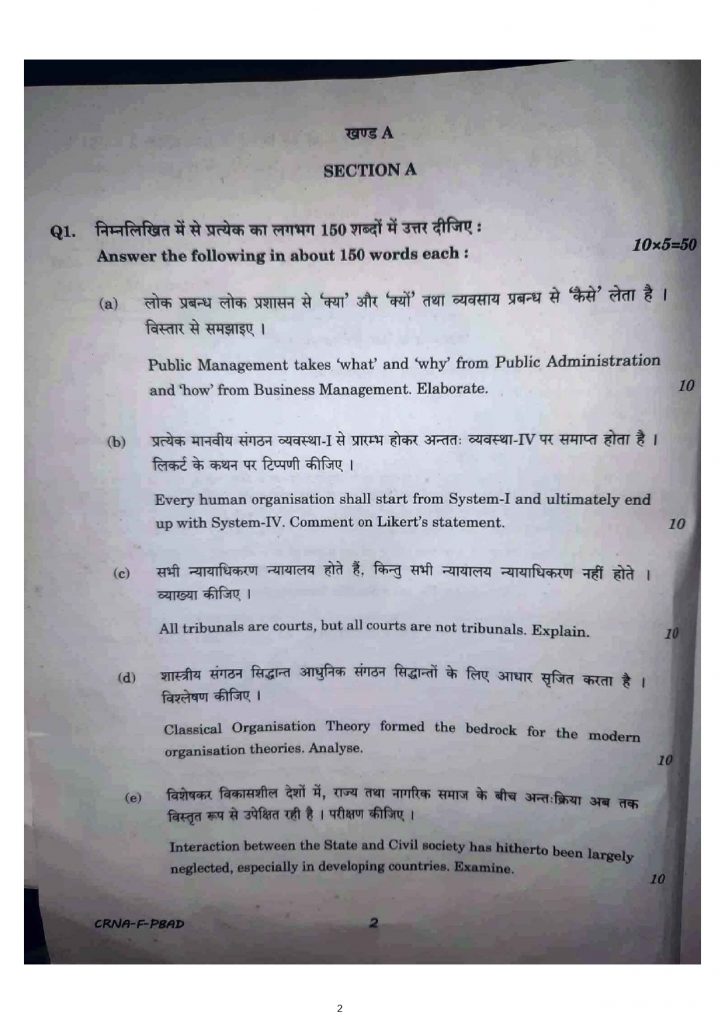

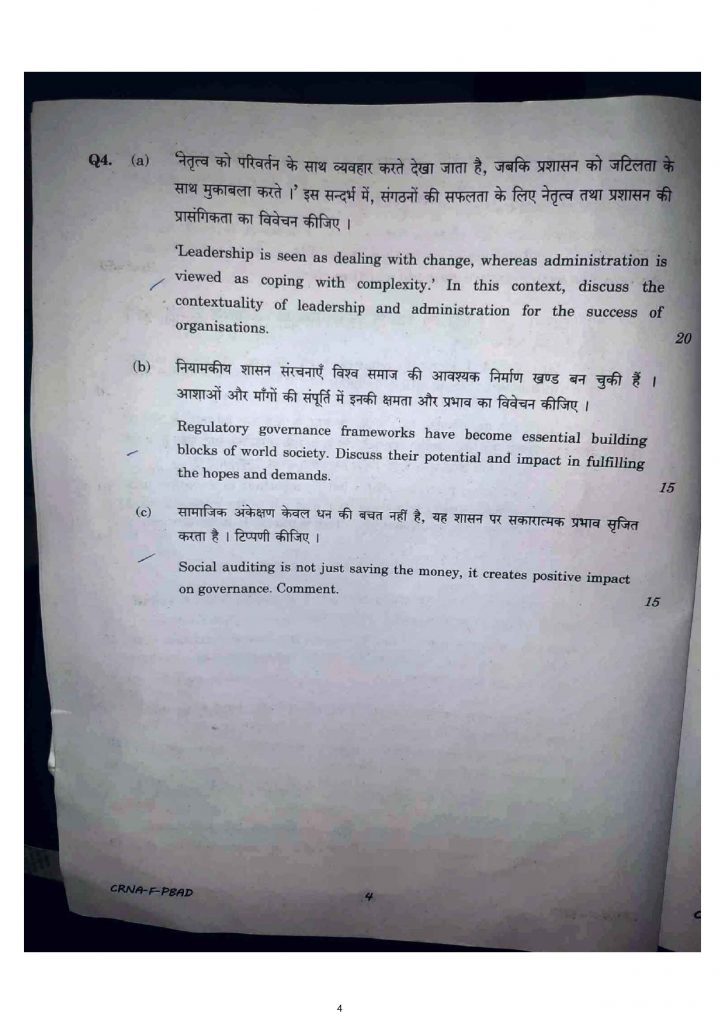

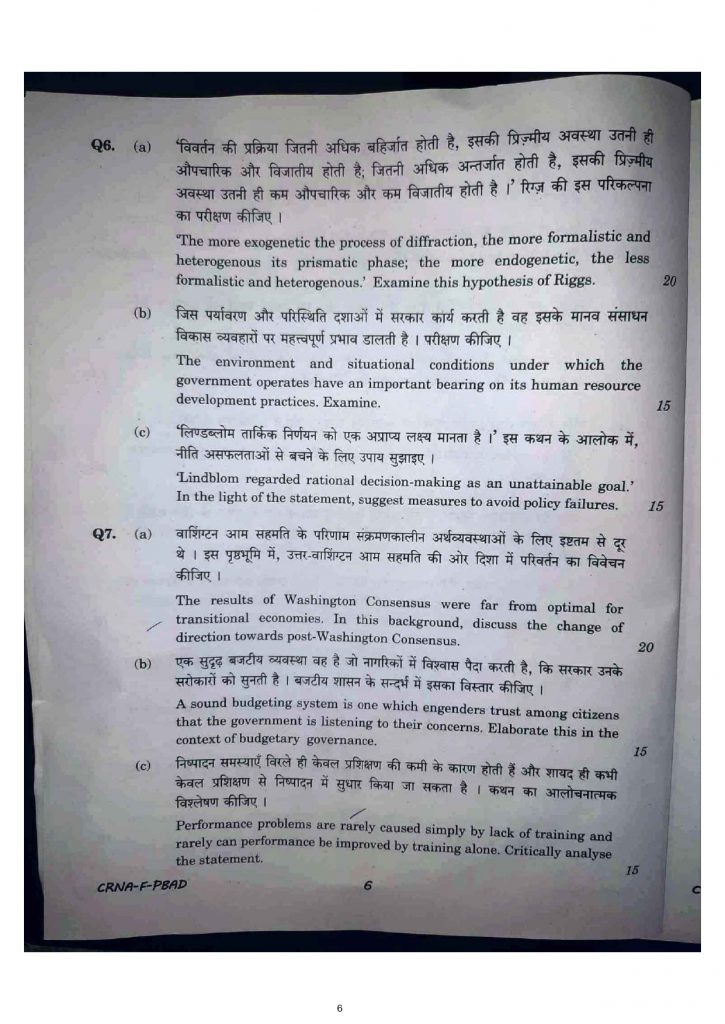
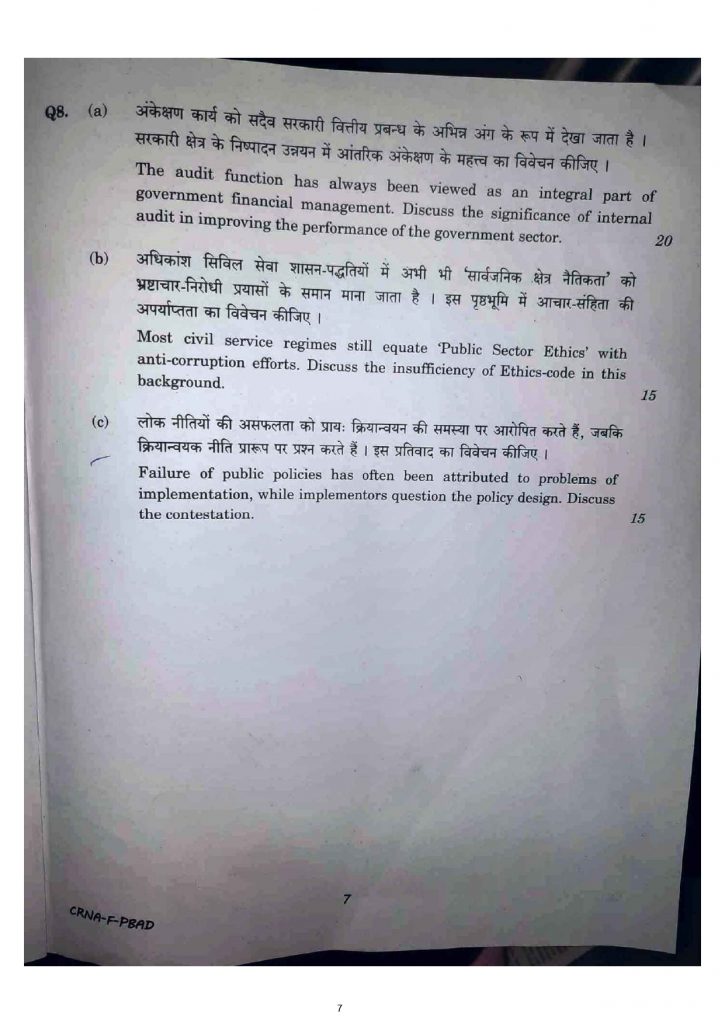
Download PDF
UPSC Mains 2022 Paper Analysis
GS PAPER-4 UPSC CSE Mains-2022
Download PDF
SECTION A
Q1. (a) Wisdom lies in knowing what to reckon with and what to overlook. An officer being engrossed with the periphery, ignoring the core issues before him, is no rare in the bureaucracy. Do you agree that such preoccupation of an administrator leads to travesty of justice to the cause of effective service delivery and good governance? Critically evaluate. (Answer in 150 words) 10
(b) Apart from intellectual competency and moral qualities, empathy and compassion are some of the other vital attributes that facilitate the civil servants to be more competent in tackling the crucial issues or taking critical decisions. Explain with suitable illustrations. (Answer in 150 words) 10
Q2. (a) The Rules and Regulations provided to all the civil servants are same, yet there is difference in the performance. Positive minded officers are able to interpret the Rules and Regulations in favour of the case and achieve success, whereas negative minded officers are unable to achieve goals by interpreting the same Rules and Regulations against the case. Discuss with illustrations. (Answer in 150 words) 10
(b) It is believed that adherence to ethics in human actions would ensure in smooth functioning of an organization/system. If so, what does ethics seek to promote in human life? How do ethical values assist in the resolution of conflicts faced by him in his day-to-day functioning? (Answer in 150 words) 10
Q3. What does each of the following mean to you?
(a) “Ethics is knowing the difference between what you have the right to do and what is right to do.”-Potter Stewart. (Answer in 150 words) 10
(b) “If a country is to be corruption free and become a nation of beautiful minds, I strongly feel there are three key societal members who can make a difference. They are the father, the mother and the teacher.” – Abdul Kalam. (Answer in 150 words) 10
(c) “Judge your success by what you had to give up in order to get it.” – Dalai Lama.
(Answer in 150 words) 10
Q4. (a) What do you understand by term ‘good governance’? How far recent initiatives in terms of e-Governance steps taken by the State have helped the beneficiaries? Discuss with suitable examples. (Answer in 150 words) 10
(b) Online methodology is being used for day-to-day meetings, institutional approvals in the administration and for teaching and learning in education sector to the extent telemedicine in the health sector is getting popular with the approvals of the competent authority. No doubt it has advantages and disadvantages for both the beneficiaries and system at large. Describe and discuss the ethical issues involved in the use of online method particularly to vulnerable section of society. (Answer in 150 words) 10
Q5. (a) Russia and Ukraine war has been going on for the last seven months. Different countries have taken independent stands and actions keeping in view their own national interests. We are all aware that war has its own impact on the different aspects of society, including human tragedy. What are those ethical issues that are crucial to be considered while launching the war and its continuation so far? Illustrate with justification the ethical issues involved in the given state of affair.(Answer in 150 words) 10
(b) Write short notes on the following in 30 words each : 2×5=10
(i) Constitutional morality
(ii) Conflict of interest
(iii) Probity in public life
(iv) Challenges of digitalization
(v) Devotion to duty
Q6. (a) Whistle blower, who reports corruption and illegal activities, wrongdoing and misconduct to the concerned authorities, runs the risk of being exposed to grave danger, physical harm and victimization by the vested interests, accused persons and his team. What policy measures would you suggest to strengthen protection mechanism to safeguard the whistle blower? (Answer in 150 words) 10
(b) In contemporary world, corporate sector’s contribution in generating wealth and employment is increasing. In doing so, they are bringing in unprecedented onslaught on the climate, environmental sustainability and living conditions of human beings. In this background, do you Responsibility (CSR) is efficient and sufficient enough to fulfill the social roles and responsibilities needed in the corporate work mandated? Critically examine. (Answer in 150 words) 10
SECTION B
Q7. Prabhat was working as Vice President (Marketing) at Sterling Electric Ltd., a reputed multinational company. But presently the company was passing through the difficult times as the sales were continuously showing downward trend in the last two quarters. His division, which hitherto had been a major revenue contributor to the company’s financial health, was now desperately trying to procure some big government order for them. But their best efforts did not yield any positive success or breakthrough.
His was a professional company and his local bosses were under pressure from their London-based HO to show some positive results. In the last performance review meeting taken by the Executive Director (India Head), he was reprimanded for his poor performance. He assured them that his division is working on a special contract from the Ministry of Defence for a secret installation near Gwalior and tender is being submitted shortly.
He was under extreme pressure and he was deeply perturbed. What aggravated the situation further was a warning from the top that if the deal is not clinched in favour of the company, his division might have to be closed and he may have to quit his lucrative job.
There was another dimension which was causing him deep mental torture and agony. This pertained to his personal precarious financial health. He was a single earner in the family with two school-college going children and his old ailing mother. The heavy expenditure on education and medical was causing a big strain to his monthly pay packet. Regular EMI for housing loan taken from bank unavoidable and any default would render him liable for severe legal action.
In the above backdrop, he was hoping for some miracle to happen. There was sudden turn of events. His Secretary informed that a gentleman Subhas Verma wanted to see him as he was interested in the position of Manager which was to be filled by him in the company. He further brought to his notice that his CV has been received through the office of the Minister of Defence.
During interview of the candidate-Subhash Verma, he found him technically sound, resourceful and experienced marketeer. He seemed to be well-conversant with tendering procedures and having knack of follow-up and liaising in this regard Prabhat felt that he was better choice than the rest of the candidates who were recently interviewed by him in the last few days.
Subhash Verma also indicated that he was in possession of the copies of the bid documents that the Unique Electronics Ltd. would be submitting the next day to the Defence Ministry for their tender. He offered to hand over those documents subject to his employment in the company on suitable terms and conditions. He made it clear that in the process, the Sterling Electric Ltd. could outbid their rival company and get the bid and hefty Defence Ministry order. He indicated that it will be win-win situation for both-him and the company.
Prabhat was absolutely stunned. It was a mixed feeling of shock and thrill. He was uncomfortable and perspiring. If accepted, all his problems would vanish instantly and he may be rewarded for securing the much awaited tender and thereby boosting company’s sales and financial health. He was in a fix as to the future course of action. He was wonder-struck at the guts of Subhash Verma in having surreptitiously removing his own company papers and offering to the rival company for a job. Being an experienced person, he was examining the pros and cons of the proposal/situation and he asked him to come the next day.
(a) Discuss the ethical issues involved in the case.
(b) Critically examine the options available to Prabhat in the above situation.
(c) Which of the above would be the most appropriate for Prabhat and why? (Answer in 250 words) 20
Q8. Ramesh is State Civil Services Officer who got the opportunity of getting posted to the capital of a border State after rendering 20 years of service. Ramesh’s mother has recently been detected cancer and has been admitted in the leading cancer hospital of the city. His two adolescent children have also got admission in one of the best public schools of the town. After settling down in his appointment as Director in the Home Department of the State, Ramesh got confidential report through intelligence sources that illegal migrants are infiltrating in the State from the neighbouring country. He decided to personally carry out surprise check of the border posts along with his Home Department team. To his surprise, he caught red-handed two families of 12 members infiltrated with the connivance of the security personnel at the border posts. On further inquiry and investigation, it was found that after the migrants from neighbouring country infiltrate, their documentation like Aadhaar Card, Ration Card and Voter Card are also forged and they are made to settle down in a particular area of the State. Ramesh prepared the detailed and comprehensive report and submitted to the Additional Secretary of the State. However, he has summoned by the Additional Home Secretary after a week and was instructed to withdraw the report. The Additional Home Secretary informed Ramesh that the report submitted by him has not been appreciated by the higher authorities. He further cautioned him that if he fails to withdraw the confidential ort, he will not only be posted out from the prestigious appointment from the State capital but his further promotion which is due in near future will also get in jeopardy.
(a) What are the options available to Ramesh as the Director of the Home Department of the bordering State?
(b) What option should Ramesh adopt and why?
(c) Critically evaluate each of the options.
(d) What are the ethical dilemmas being faced by Ramesh?
(e) What policy measures would you suggest to combat the menace of infiltration of illegal migrants from the neighbouring country?(Answer in 250 words) 20
Q9. The Supreme Court has banned mining in the Aravalli Hills to stop degradation the forest cover and to maintain ecological balance. However, the stone mining to still prevalent in the border district of the affected State with connivance of certain corrupt forest officials and politicians. Young and dynamic SP who was recently posted in the affected district promised to himself to stop this menace. In one of his surprise checks with his team, he found loaded truck with stone trying to escape the mining area. He tried to stop the truck but the truck driver overrun the police officer, killing him on the spot and thereafter managed to flee. Police filed FIR but no breakthrough was achieved in the case for almost three months. Ashok who was the Investigative Journalist working with leading TV channel, suo moto started investigating the case. Within one month, Ashok got breakthrough by interacting with local people, stone mining masia and government officials. He prepared his investigative story and presented to the CMD of the TV channel. He exposed in his investigative report the complete nexus of stone mafia working with blessing of corrupt police and civil officials and politicians. The politician who was involved in the mafia was no one else but local MLA who was considered to be very close to the Chief Minister. After going through the investigative report, the CMD advised Ashok to drop the idea of making the story public through electronic media. He informed that the local MLA was not only the relative of the owner of the TV channel but also had unofficially 20 percent share in the channel. The CMD further informed Ashok that his further promotion and hike in pay will be taken care of in addition the soft loan of 10 lakhs which he has taken from the TV channel for his son’s chronic disease will be suitably adjusted if he hands over the investigative report to him.
(a) What are the options available with Ashok to cope up with the situation?
(b) Critically evaluate/examine each of the options identified by Ashok.
(c) What are the ethical dilemmas being faced by Ashok?
(d) Which of the options, do you think, would be the most appropriate for Ashok to adopt and why?
(e) In the above scenario, what type of training would you suggest for police officers posted to such districts where stone mining illegal activities are rampant? (Answer in 250 words) 20
Q 10. You have done MBA from a reputed institution three years back but could not get campus placement due to COVID-19 generated recession. However, after a lot of persuasion and series of competitive tests including written and interview, you managed to get a job in a leading shoe company. You have ageur parents who are dependent and staying with you. You also recently got married after getting this decent job. You were allotted the Inspection Section which is responsible for clearing the final product. In first one year, you learnt your job well and was appreciated for your performance by the management. The company is doing good business for last five years in domestic market and this year it is decided even to export to Europe and Gulf countries. However, one large consignment to Europe was rejected by their Inspecting Team due to certain poor quality and was sent back. The top management ordered that ibid consignment to be cleared for the domestic market. As a part of Inspecting Team, you observed the glaring poor quality and brought to the knowledge of the Team Commander. However, the top management advised all the members of the team to overlook these defects as the management cannot bear such a huge loss. Rest of the team members except you promptly signed and cleared the consignment for domestic market, overlooking glaring defects. You again brought to the knowledge of the Team Commander that such consignment, if cleared even for domestic market, will tarnish the image and reputation of the company and will be counter-productive in the long run. However, you were further advised by the top management that if you do not clear the consignment, the company will not hesitate to terminate your services citing certain innocuous reasons.
(a) Under the given conditions, what are the options available to you as a member of the Inspecting Team?
(b) Critically evaluate each of the options listed by you.
(c) What option would you adopt and why?
(d) What are the ethical dilemmas being faced by you?
(e) What can be the consequences of overlooking the observations raised by the Inspecting Team? (Answer in 250 words) 20
Q11. Rakesh was working as a Joint Commissioner in Transport department of a city. As a part of his job profile, among others, he was entrusted with the task of overseeing the control and functioning of City Transport Department. A case strike by drivers’ union of City Transport Department over the issue of compensation to a driver who died on duty while driving the bus came up before him for decision in the matter.
He gathered that the driver (deceased) was plying Bus No. 528 which passed through busy and congested roads of the city. It so happened that near an intersection on the way, there was an accident involving the a middle-aged man. It was found that there was altercation between the driver and the car driver. Heated arguments between them led to fight and the driver gave him a a blow. Lot of passerbys had gathered and tried to intervene but without success. Eventually, both of them were badly injured and profusely bleeding and were taken to the nearby hospital. The driver succumbed to the injuries and could not be saved. The middle-aged driver’s condition was also critical but after a day, he recovered and was discharged. Police had immediately come to the spot and FIR was registered. Police investigation revealed that the quarrel in was started by the bus driver and he had resorted to physical violence. There exchange of blows between them.
The City Transport Department management is considering of not giving any extra compensation to the driver’s (deceased) family. The family is very aggrieved. depressed and agitated against the discriminatory and non-sympathetic approach of the City Transport Department management. The bus driver (deceased) was 52 years of age, was survived by his wife and two school-college going daughters. He was the sole earner of the family. The City Transport Department workers’ union took up this case and when found no favourable response from the management, decided to go on strike. The union’s demand was two fold. First was full extra compensation as given to other drivers who died on duty and secondly employment to one family member. The strike has continued for 10 days and the deadlock remains.
(a) What are the options available to Rakesh to meet the above situation?
(b) Critically examine each of the options identified by Rakesh
(c) What are the ethical dilemmas being faced by Rakesh?
(d) What course of action would Rakesh adopt to diffuse the above situation?(Answer in 250 words) 20
Q12. You are appointed as an officer heading the section in Environment Pollution Control Board to ensure compliance and its follow-up. In that region, there were large number of small and medium industries which had been granted clearance. You learnt that these industries provide employment to many migrant worker. Most of the industrial units have got environmental clearance certificate in their possession. The environmental clearance seeks to curb industries and projects that supposedly hamper environment and living species in the region, But in practice. most of these units remain to be polluting units in several ways like air, water and soil pollution. As such, local people encountered persistent health problems.
It was confirmed that majority of the industries were violating environmental compliance. You issued notice to all the industrial units to apply for fresh environmental clearance certificate from the competent authority. However, your action met with hostile response from a section of the industrial units, other vested interest persons and a section of the local politicians. The workers also became hostile to you as they felt that your action would lead to the closure of these industrial units, and the resultant unemployment will lead to insecurity uncertainty in their livelihood. Many owners of the industries approached you with the plea that you should not initiate harsh action as it would compel them their units, and cause huge financial loss, shortage of their products in the market. These would obviously add to the sufferings of the labourers and the consumers alike. The labour union also sent you representation requesting against the closure of the units. You simultaneously started receiving threats from unknown corners. You however received supports from some of your colleagues, who advised you to act freely to ensure environmental compliance. Local NGOs also came to your support and they demanded the closure of the polluting units immediately.
(a) What are the options available to you under the given situation?
(b) Critically examine the options listed by you.
(c) What type of mechanism would you suggest to ensure environmental compliance?
(d) What are the ethical dilemmas you faced in exercising your option?(Answer in 250 words) 20
GS PAPER-3: UPSC CSE Mains-2022
https://youtu.be/mw9MNcuUxTYhttps://youtu.be/4BXQo5M83jc
Q1. Why is Public Private Partnership (PPP) required in infrastructural projects? Examine the role of PPP model in the redevelopment of Railway Stations in India.
(Answer in 150 words) 10
Q2. Is inclusive growth possible under market economy? State the significance of financial inclusion in achieving economic growth in India.
(Answer in 150 words) 10
Q3. What are the major challenges of Public Distribution System (PDS) in India? How can it be made effective and transparent?
(Answer in 150 words ) 10
Q4. Elaborate the scope and significance of the food processing industry in India.
(Answer in 150 words) 10
Q5. The increase in life expectancy in the country has led to newer health challenges in the community. What are those challenges and what steps need to be taken to meet them ?
(Answer in 150 words ) 10
Q6. Each year a large amount of plant material, cellulose, is deposited on the surface of Planet Earth.What are the natural processes this cellulose undergoes before yielding carbon dioxide, water and other end products?
(Answer in 150 words) 10
Q7. Discuss in detail the photochemical smog emphasizing its formation, effects and mitigation, Explain the 1999 Gothenburg Protocol.
(Answer in 150 words) 10
Q8. Explain the mechanism and occurrence of cloudburst in the context of the Indian subcontinent. Discuss two recent examples.
(Answer in 150 words) 10
Q9. Discuss the types of organised crimes. Describe the linkages between terrorists and organised crime that exist at the national and transnational levels.
(Answer in 150 words)10
Q10. What are the maritime security challenges in India? Discuss the organisational, technical and procedural initiatives taken to improve the maritime security.
(Answer in 150 words ) 10
Q11. “Economic growth in the recent past has been led by increase in labour productivity.” Explain this statement. Suggest the growth pattern that will lead to creation of more jobs without compromising labour productivity.
(Answer in 250 words) 15
Q12. Do you think India will meet 50 percent of its energy needs from renewable energy by 2030 ? Justify your answer. How will the shift of subsidies from fossil fuels to renewables help achieve the above objective? Explain.
(Answer in 250 words) 15
Q13. What are the main bottlenecks in upstream and downstream process of marketing of agricultural products in India ?
(Answer in 250 words) 15
Q14. What is Integrated Farming System? How is it helpful to small and marginal farmers in India ?
(Answer in 250 words) 15
Q15. Launched on 25th December, 2021, James Webb Space Telescope has been much in the news since then. What are its unique features which make it superior to its predecessor Space Telescopes? What are the key goals of this mission? What potential benefits does it hold for the human race?
(Answer in 250 words) 15
Q16. What is the basic principle behind vaccine development? How do vaccines work? What approaches were adopted by the Indian vaccine manufacturers to produce COVID-19 vaccines?
(Answer in 250 words) 15
Q17. Discuss global warming and mention its effects on the global climate. Explain the control measures to bring down the level of greenhouse gases which cause global warming, in the light of the Kyoto Protocol, 1997.
(Answer in 250 words) 15
Q18. Explain the causes and effects of coastal erosion in India. What are the available coastal management techniques for combating the hazard?
(Answer in 250 words) 15
Q19. What are the different elements of cyber security? Keeping in view the challenges in cyber security, examine the extent to which India has successfully developed a comprehensive National Cyber Security Strategy.
(Answer in 250 words) 15
Q20. Naxalism is a social, economic and developmental issue manifesting as a violent internal security threat. In this context, discuss the emerging issues and suggest a multilayered strategy to tackle the menace of Naxalism.
(Answer in 250 words) 15
GS PAPER-2: UPSC CSE Mains-2022
Q.1 “The most significant achievement of modern law in India is the constitutionalization of environmental problems by the Supreme Court.” Discuss this statement with the help of relevant case laws.
(Answer in 150 words ) 10
Q.2 “Right of movement and residence throughout the territory of India are freely available to the Indian citizens, but these rights are not absolute. “ Comment.
(Answer in 150 words ) 10
Q.3 To what extent, in your opinion, has the decentralisation of power in India changed the governance landscape at the grassroots?
(Answer in 150 words ) 10
Q.4 Discuss the role of the Vice –President of India as the Chairman of the Rajyasabha.
(Answer in 150 words ) 10
Q.5 Discuss the role of the National Commission for Backward Classes in the wake of its transformation from a statutory body to a constitutional body.
(Answer in 150 words ) 10
Q.6 The Gati-Shakti Yojana needs meticulous coordination between the government and the private sector to achieve the goal of connectivity. Discuss.
(Answer in 150 words ) 10
Q.7 The Rights of Persons with Disabilities Act, 2016 remains only a legal document without intense sensitisation of government functionaries and citizens regarding disability. Comment.
(Answer in 150 words ) 10
Q.8 Reforming the government delivery system through the Direct Benefit Transfer Scheme is a progressive step, but it has its limitations too. Comment.
(Answer in 150 words ) 10
Q.9 ‘India is an age-old friend of Sri Lanka.’ Discuss India’s role in the recent crisis in Sri Lanka in the light of the preceding statement.
(Answer in 150 words ) 10
Q.10 Do you think that BIMSTEC is a parallel organisation like the SAARC ? What are the similarities and dissimilarities between the two ? How are Indian foreign policy objectives realized by forming this new organisation ?
(Answer in 150 words ) 10
Q.11 Discuss the procedures to decide the disputes arising out of the election of a Member of the Parliament or State Legislature under The Representation of the People Act, 1951. What are the grounds on which the election of any returned candidate may be declared void? What remedy is available to the aggrieved party against the decision ? Refer to the case laws.
(Answer in 250 words) 15
Q.12 Discuss the essential conditions for exercise of the legislative powers by ne Governor. Discuss the legality of re-promulgation of ordinances by the Governor without placing them before the Legislature.
(Answer in 250 words) 15
Q.13 While the national political parties in India favour centralisation, the regional parties are in favour of State autonomy.” Comment.
(Answer in 250 words) 15
Q.14 Critically examine the procedures through which the Presidents of India and France are elected.
(Answer in 250 words) 15
Q.15 Discuss the role of the Election Commission of India in the light of the evolution of the Model Code of Conduct.
(Answer in 250 words) 15
Q.16 Besides the welfare schemes, India needs deft management of inflation and unemployment to serve the poor and the underprivileged sections of the society. Discuss.
(Answer in 250 words) 15
Q.17 Do you agree with the view that increasing dependence on donor agencies for development reduces the importance of community participation in the development process ? Justify your answer.
(Answer in 250 words) 15
Q.18 The Right of Children to Free and Compulsory Education Act, 2009 remains inadequate in promoting incentive-based system for children’s education without generating awareness about the importance of schooling. Analyse
(Answer in 250 words) 15
Q.19 How will I2U2 (India, Israel, UAE and USA) grouping transform India’s position in global politics?
(Answer in 250 words) 15
Q.20 Clean energy is the order of the day.’ Describe briefly India’s changing policy towards climate change in various international fora in the context of geopolitics.
(Answer in 250 words) 15
GS PAPER-1: UPSC CSE Mains-2022
https://youtu.be/xI_rHAKweHQhttps://youtu.be/66y_B3bFyPUhttps://youtu.be/yqlmdWsnEzs
Q.1. How will you explain that medieval Indian temple sculptures represent the social life of those days ?
(Answer in 150 words ) 10
Q.2 Why did the armies of the British East India Company- mostly comprising of Indian soldiers-win consistently against the more numerous and better equipped armies of the then Indian rulers ? Give reasons.
(Answer in 150 words) 10
Q.3 Why was there a sudden spurt in famines in colonial India since the mid-eighteenth century? Give reasons.
(Answer in 150 words) 10
Q.4 Describe the characteristics and types of primary rocks.
(Answer in 150 words ) 10
Q.5 Discuss the meaning of colour-coded weather warnings for cyclone prone areas given by India Meteorological Department.
(Answer in 150 words) 10
Q.6 Discuss the natural resource potentials of ‘Deccan Trap’
(Answer in 150 words ) 10
Q.7 Examine the potential of wind energy in India and explain the reasons for their limited spatial spread.
(Answer in 150 words) 10
Q.8 Explore and evaluate the impact of ‘Work From Home’ on family relationships.
(Answer in 150 words ) 10
Q.9 How is the growth of Tier 2 cities related to the rise of a new middle class with an emphasis on the culture of consumption ?
(Answer in 150 words) 10
Q.10 Given the diversities among tribal communities in India, in which specific contexts should they be considered as a single category ?
(Answer in 150 words ) 10
Q.11 The political and administrative reorganization of states and territories has been a continuous ongoing process since the mid-nineteenth century. Discuss with examples.
(Answer in 250 words) 15
Q.12 Discuss the main contributions of Gupta period and Chola period to Indian heritage and culture.
(Answer in 250 words) 15
Q.13 Discuss the significance of the lion and bull figures in Indian mythology, art and architecture.
(Answer in 250 words) 15
Q.14 What are the forces that influence ocean currents? Describe their role in fishing industry of the world.
(Answer in 250 words) 15
Q.15 Describing the distribution of rubber producing countries, indicate the major environmental issues faced by them.
(Answer in 250 words) 15
Q.16 Mention the significance of straits and isthmus in international trade.
(Answer in 250 words ) 15
Q.17 Troposphere is a very significant atmospheric layer that determines weather processes How?
(Answer in 250 words) 15
Q.18 Analyse the salience of ‘sect’ in Indian society vis-a-vis caste, region and religion.
(Answer in 250 words) 15
Q.19 Are tolerance, assimilation and pluralism the key elements in the making of an Indian form of secularism ? Justify your answer.
(Answer in 250 words ) 15
Q.20 Elucidate the relationship between globalization and new technology in a world of scarce resources, with special reference to India.
(Answer in 250 words) 15
Essay Question Paper: UPSC CSE Mains 2022
Section A
- 1. Forests are the best case studies for economic excellence
- 2. Poets are the unacknowledged legislators of the world
- 3. History is a series of victories won by the scientific man over the romantic man
- 4. A ship in harbour is safe, but that is not what ship is for
Section B
- 5. The time to repair the roof is when the sun is shining
- 6. You cannot step twice in the same river
- 7. A smile is the chosen vehicle for all ambiguities
- 8. Just because you have a choice, it does not mean that any of them has to be right
THE HIGHLIGHTS OF THE BUDGET 2022-2023
THE CONTEXT: The Union Budget seeks to complement macro-economic level growth with a focus on micro-economic level all-inclusive welfare. The union minister for Finance &
Corporate Affairs, tabled the Union Budget 2022-23 in Parliament on February 2022.
PART A
- India’s economic growth estimated at 9.2% to be the highest among all large economies.
- 60 lakh new jobs to be created under the productivity linked incentive scheme in 14 sectors.
- PLI Schemes have the potential to create an additional production of Rs 30 lakh crore.
THE HIGHLIGHTS OF THE ECONOMIC SURVEY 2021-2022

THE CONTEXT: The Union Minister for Finance & Corporate Affairs, presented the Economic
Survey 2021-22 in Parliament on 31 January 2022. The highlights of the Economic Survey are as follows:
STATE OF THE ECONOMY
- Indian economy estimated to grow by 9.2 percent in real terms in 2021-22 (as per first advanced estimates) subsequent to a contraction of 7.3 percent in 2020-21.
- GDP projected to grow by 8- 8.5 percent in real terms in 2022-23.
- The year ahead poised for a pickup in private sector investment with the financial system in good position to provide support for economy’s revival.
- Projection comparable with World Bank and Asian Development Bank’s latest forecasts of real GDP growth of 8.7 percent and 7.5 percent respectively for 2022-23.
- As per IMF’s latest World Economic Outlook projections, India’s real GDP projected to grow at 9 percent in 2021-22 and 2022-23 and at 7.1 percent in 2023-2024, which would make India the fastest growing major economy in the world for all 3years.
- Agriculture and allied sectors expected to grow by 3.9 percent; industry by 11.8 percent and services sector by 8.2 percent in 2021-22.
- On demand side, consumption estimated to grow by 7.0 percent, Gross Fixed Capital Formation (GFCF) by 15 percent, exports by 16.5 percent and imports by 29.4 percent in 2021-22.
- Macroeconomic stability indicators suggest that the Indian Economy is well placed to take on the challenges of 2022-23.
- Combination of high foreign exchange reserves sustained foreign direct investment, and rising export earnings will provide adequate buffer against possible global liquidity tapering in 2022-23.
- Economic impact of “second wave” was much smaller than that during the full lockdown phase in 2020-21, though health impact was more severe.
- Government of India’s unique response comprised of safety-nets to cushion the impact on vulnerable sections of society and the business sector, significant increase in capital expenditure to spur growth and supply side reforms for a sustained long term expansion.
- Government’s flexible and multi-layered response is partly based on an “Agile” framework that uses feedback-loops, and the use of eighty High Frequency Indicators (HFIs) in an environment of extreme uncertainty.
Fiscal Developments
- The revenue receipts from the Central Government (April to November, 2021) have gone up by 67.2 percent (YoY) as against an expected growth of 9.6 percent in the 2021-22 Budget Estimates (over 2020-21 Provisional Actuals).
- Gross Tax Revenue registers a growth of over 50 percent during April to November, 2021 in YoY terms. This performance is strong compared to pre-pandemic levels of 2019-2020 also.
- During April-November 2021, Capex has grown by 13.5 percent (YoY) with focus on infrastructure-intensive sectors.
- Sustained revenue collection and a targeted expenditure policy has contained the fiscal deficit for April to November, 2021 at 46.2 percent of BE.
- With the enhanced borrowings on account of COVID-19, the Central Government debt has gone up from 49.1 percent of GDP in 2019-20 to 59.3 percent of GDP in 2020-21, but is expected to follow a declining trajectory with the recovery of the economy.
External Sectors
- India’s merchandise exports and imports rebounded strongly and surpassed preCOVID levels during the current financial year.
- There was significant pickup in net services with both receipts and payments crossing the pre-pandemic levels, despite weak tourism revenues.
- Net capital flows were higher at US$ 65.6 billion in the first half of 2021-22, on account of continued inflow of foreign investment, revival in net external commercial borrowings, higher banking capital and additional special drawing rights (SDR) allocation
- India’s external debt rose to US $ 593.1 billion at end-September 2021, from US $ 556.8 billion a year earlier, reflecting additional SDR allocation by IMF, coupled with higher commercial borrowings.
- Foreign Exchange Reserves crossed US$ 600 billion in the first half of 2021-22 and touched US $ 633.6 billion as of December 31, 2021.
- As of end-November 2021, India was the fourth largest forex reserves holder in the world after China, Japan and Switzerland.
Monetary Management and Financial Intermediation
- The liquidity in the system remained in surplus.
- Repo rate was maintained at 4 per cent in 2021-22.
- RBI undertook various measures such as G-Sec Acquisition Programme and Special Long-Term Repo Operations to provide further liquidity.
- The economic shock of the pandemic has been weathered well by the commercial banking system:
- YoY Bank credit growth accelerated gradually in 2021-22 from 5.3 per cent in April 2021 to 9.2 per cent as on 31st December 2021.
- The Gross Non-Performing Advances ratio of Scheduled Commercial Banks (SCBs) declined from 11.2 per cent at the end of 2017-18 to 6.9 per cent at the end of September, 2021.
- Net Non-Performing Advances ratio declined from 6 percent to 2.2 per cent during the same period
- Capital to risk-weighted asset ratio of SCBs continued to increase from 13 per cent in 2013-14 to 16.54 per cent at the end of September 2021.
- The Return on Assets and Return on Equity for Public Sector Banks continued to be positive for the period ending September 2021.
- Exceptional year for the capital markets:
- Rs. 89,066 crore was raised via 75 Initial Public Offering (IPO) issues in April-November 2021, which is much higher than in any year in the last decade.
- Sensex and Nifty scaled up to touch peak at 61,766 and 18,477 on October 18, 2021.
- Among major emerging market economies, Indian markets outperformed peers in April-December 2021.
Prices and Inflation
The average headline CPI-Combined inflation moderated to 5.2 per cent in 2021-22 (April-December) from 6.6 per cent in the corresponding period of 2020-21.
- The decline in retail inflation was led by easing of food inflation.
- Food inflation averaged at a low of 2.9 per cent in 2021-22 (April to December) as against 9.1 per cent in the corresponding period last year.
- Effective supply-side management kept prices of most essential commodities under control during the year.
- Proactive measures were taken to contain the price rise in pulses and edible oils.
- Reduction in central excise and subsequent cuts in Value Added Tax by most States helped ease petrol and diesel prices.
Wholesale inflation based on Wholesale Price Index (WPI) rose to 12.5 per cent during 2021-22 (April to December). This has been attributed to:
- Low base in the previous year,
- Pick-up in economic activity,
- Sharp increase in international prices of crude oil and other imported inputs, and
- High freight costs.
Divergence between CPI-C and WPI Inflation:
- The divergence peaked to 9.6 percentage points in May 2020.
- However, this year there was a reversal in divergence with retail inflation falling below wholesale inflation by 8.0 percentage points in December 2021.
This divergence can be explained by factors such as:
- Variations due to base effect,
- Difference in scope and coverage of the two indices,
- Price collections,
- Items covered,
- Difference in commodity weights, and
- WPI being more sensitive to cost-push inflation led by imported inputs.
With the gradual waning of base effect in WPI, the divergence in CPI-C and WPI is also expected to narrow down.
DOWNLOAD PDF
